SIGNALS quarterly

FROZEN IN TIME
Conserving Antarctica’s heroic-era huts
WHALING IN AUSTRALIA
The end of a controversial era
TIMBER SHIPBUILDING
A thriving colonial trade


Conserving Antarctica’s heroic-era huts
The end of a controversial era
A thriving colonial trade

AUSTRALIA’S MARITIME HISTORY is intertwined with that of many nations both near and far, and we often work in creative as well as research collaborations with museums from around the world.
One such project, our exhibition On Their Own: Britain’s Child Migrants, will travel to England in October this year, going on show at the National Museums Liverpool before moving in 2015 to the V&A Museum of Childhood in London. On Their Own, which has already travelled to regional venues throughout Australia, explores the shared child-migrant history of this country, the United Kingdom and Canada.
The history of the Royal Australian Navy (RAN) is another that has been played out all around the globe, in various theatres of war. So the Australian National Maritime Museum has started a new program working closely with the RAN and Department of Veterans’ Affairs, to protect important sites and wrecks overseas. One of these is the wreck off the Turkish coast of the RAN submarine AE2, the only RAN vessel lost to enemy action in World War I.
In June this year the AE2 project team will attempt to deploy two ROVs (Remote Operated Vehicles) inside the submarine to capture video footage, revealing the vessel’s interior for the first time since it was scuttled on 30 April 1915 in the Sea of Marmara, after its pressure hull was pierced by a Turkish gunboat. The project is the result of many years’ work, including the construction of a full-scale replica of AE2 ’s conning tower and part of the hull, which was lowered into Corio Bay in Victoria to test divers and equipment. The museum is working closely with the project and will take responsibility for its archives and its conservation work in 2015, when the project completes its final phase.
Another international collaboration involves arguably Australia’s most famous ship – Lieutenant James Cook’s HM Bark Endeavour. While many of us know about Cook’s work charting the east coast of Australia in 1770, what happened to HM Bark Endeavour following her return to England was, until recently, a mystery.
After Cook’s first Pacific voyage, Endeavour was discharged from the Royal Navy and sold. US archaeologist and historian Dr Kathy Abbass of the Rhode Island Marine Archaeological Project (RIMAP) established that Endeavour (under a new name, Lord Sandwich) was one of 12 vessels scuttled by the British military in Newport Harbour, Rhode Island, in 1778 to protect the port from the French during the American War of Independence.
RIMAP, headed by Dr Abbass, has been diving and surveying this fleet over the last 20 years. The Australian National Maritime Museum’s maritime archaeologists have been actively involved in the hunt for Endeavour ’s remains and have dived on the site five times, most recently in 2007. I travelled to Rhode Island in March this year to meet with Dr Abbass and her team to agree on the next steps in renewing our partnership.
As the museum develops its plans for new galleries, visitors will be able to see the tangible results of these international collaborations. Our new Warships Pavilion will tell the story of both AE1 and AE2, and in 2020, on the occasion of the 250th anniversary of HM Bark Endeavour ’s arrival off the east coast of Australia, we plan to open a major new Pacific exploration gallery.
Kevin Sumption
Museum Director Kevin Sumption with the museum’s HMB Endeavour replica. Photograph Sam Mooy/Newspix. Reproduced with permission
Cover: Captain Robert Falcon Scott’s expedition base from the British Antarctic ( Terra Nova) Expedition of 1910–13. The hut stands at Cape Evans, Ross Island, below Mt Erebus, the world’s southernmost active volcano. Today, the hut contains more than 10,500 artefacts, most of which have now been conserved. The Antarctic Heritage Trust’s on-ice conservation team is treating the final 800 of those artefacts this winter (see story on page 64).
From commerce to conservation: changing views on whales and whaling
War in miniature, depicted in a vivid diorama of Suvla Bay
The rich history of Western Australia’s seagoers and their craft
The thriving trade of timber shipbuilding in colonial New South Wales
Personal tales shed light on Australia’s post-World War II immigration policies
An ambitious building project gets under way at the museum
Building a replica of a champion skiff
A new exhibition reimagines the first meetings between Europeans and Indigenous Australians
The museum develops a versatile new waterside venue
The latest exhibitions in our galleries this season
Discovery Bay’s Historic Whaling Station, Western Australia
The master of our Endeavour replica describes what it takes to maintain this unique ship
Conserving century-old huts from the heroic era of polar exploration
Whaleboats, sailboats, Indigenous canoes and a Cold-War submarine
Filipino merchant mariners remembered; a wartime mystery solved; a visit from our poster girl
Arthur Phillip by Michael Pembroke; Natural Curiosity by Louise Anemaat
A famous skiff goes back on the water, and old crewmates reconnect via the internet

A Cheynes Beach Whaling Station vessel, the Cheynes II, as seen from a Zodiac in September 1977, its whale cannon mounted on the bow. Norwegian sealer and whaler Svend Foyn invented the explosive harpoon in the 1860s, leading to the near-extinction of many species of whale that had previously been relatively safe from whalers. ANMM Collection. Photograph Jonny Lewis
Whale oil, and whale bone, remained Australia’s number one export until 1835, when wool took over
When the early settlement of Australia is discussed, the usual focus is our agricultural beginnings and our intrepid explorers of the land. Much less emphasised is our history of whaling and its contribution both to the early economy of the colonies and to the growth of fledgling coastal settlements. Curatorial assistant Myffanwy Bryant looks into this once lucrative and now controversial industry.
AS CONTEMPORARY AUSTRALIANS, we embrace our immigrant and convict roots, but seem less inclined to acknowledge our whaling forefathers, those brave and resilient hunters who, in the early days, chased down whales with little other than small wooden boats and a very stout heart. It seems we would rather not see ourselves as one of the great whaling countries of the 19th century. And yet we were. Indeed, Australia had the last operating whaling station in the English-speaking world. It was not until 1978, only 36 years ago, that the Cheynes Beach Whaling Station at Albany in Western Australia closed.
Whaling began in the west of Australia even before there was any substantial settlement. The land in the west was arid and unforgiving, but the sea was rich in marine life, particularly whales. In a century that virtually ran on whale oil, these southern oceans were akin to goldfields, abundant in natural resources that were owned
by no one and ready for the taking. Whale oil powered the great machines of industry during the booming industrial age and lit the lamps of the grand houses and businesses of Europe and America.
The whaling industry literally fuelled the world. So before Australia was ready to export any other goods, whale oil and whale bone provided economic viability. Whaling’s potential for profit led to the establishment of a military outpost at Albany in 1826, needed to protect British interests in the region. Indeed, the governor of New South Wales, Ralph Darling, ordered that if the French were found to be settled there already, they should be told to leave, as Britain now owned the entire continent of New Holland, as Australia was then known. What had begun as sea harvesting by small bands of rogue sealers and passing whalers now grew to include hundreds of local and international whaling ships arriving at onshore whaling stations to feed
the insatiable international market, and so helping to found the economy of Australia’s west. Whale oil, and whale bone, remained Australia’s number one export until 1835, when wool took over – although even with wool leading the exports, there were still some 300 American whaling ships operating off Australia’s west coast.
Inevitably, however, the world began to change; whale numbers were decreasing, and new alternatives such as camphene oil were being more widely used. Across the seas in England and America, attention became focused on something quite different, something that would change the world forever: petroleum. However, the whale industry was not yet at an end. Despite the cheaper and more accessible alternatives available, the high quality and various properties of whale oil were not so easily replaced and the west-coast whaling industry struggled
Tourists visited the Cheynes Beach Whaling Station to watch the flensing of a carcass

01 Flakes of spermaceti, a white waxy substance found in the head of the sperm whale and used for candles and ointments. ANMM Collection
02 A large crowd of tourists watches a whale carcass being flensed at Cheynes Beach Whaling Station in the 1970s. Photograph by Ed Smidt. Reproduced courtesy Ingrid Smidt
03 A sperm whale alongside the whaling ship Cheynes III. Photograph by Ed Smidt. Reproduced courtesy Ingrid Smidt
04 A whale chaser off Albany, Western Australia. Photograph by Ed Smidt. Reproduced courtesy Ingrid Smidt
on even after its east-coast counterpart had given up. Whale oil still had many important uses in the modern world – even into the 1960s whale oil was used in the garment and leather industries and as a lubricant for high-altitude instruments, and some musicians can still recall the superiority of recording tape lubricated by whale oil.
With a market still existing for whale oil, the Cheynes Beach Whaling Station was established in 1952 by some local fishermen. It became an important employer in Albany, and the whalers, despite modern technological advances, were still seen by many as tough, hard-working men. It took great commitment to establish and maintain the station in those early years. The location was isolated and the conditions under which the whalers lived and worked were difficult. The camaraderie, resilience and seamanship involved in whaling had not lessened over the years.
The 20th-century whalers, like their predecessors, had no great love for killing and processing whales. It was, as it always had been, a harsh, labour-intensive and stomach-churning job. But it was a job, and work both before and after the whaling industry was hard to find in such remote towns as Albany. By the 1970s, towards the end of the industry’s reign, Albany had the highest unemployment rate in Western Australia and the Cheynes Beach Station not only provided much-needed work for some, it also supported the town and added to Australia’s export market. At its peak, the company took between 900 and 1100 sperm and humpback whales each year for processing. In 1963, the International Whaling Commission banned the killing of humpback whales due to their dwindling numbers, so the whalers of Cheynes Beach Station had to hunt further afield, solely for the sperm whale.
The station also became an attraction for outsiders. Accounts of touring Western Australia tell of visitors to the station watching the flensing of a carcass. It was the only place in Australia where you could see a whale so close, and despite the gruesomeness of the task, there was interest in watching whalers who were skilled at their jobs and who seemed willing to be seen by the public hard at work.
But again, developments overseas, and throughout Australia, would directly affect this small, remote community
of whalers. This time changes would be aided by a very small band of dedicated people determined to show the world that whaling was inhumane, brutal and unnecessary. This small but passionate group was known as Greenpeace. It was less than 10 years old but had already made an international name for itself by protesting against Russian whaling in the Pacific. This was a new style of activism, in which protesters physically intervened with the ships at sea and put themselves between the whale and the hunters. Greenpeace was media savvy, direct and fearless. It was exactly what local Australian anti-whaling groups, the Whale and Dolphin Coalition and Project Jonah, needed to take the fight directly to Cheynes Beach Whaling Station.
Greenpeace had developed the tactic of using Zodiacs, inflatable dinghies, to follow whaling ships to sea. It is a familiar sight to us today, but in 1977 it was unprecedented. The media attention that followed made a huge impact. It is one thing to tell the public about the brutality of whaling, but another to show the reality on televisions around the world. Protestors against the Vietnam War had realised the power of moving images, and now this new group of eco-warriors used the same technique. By the late 1970s a large proportion of Australians was against whaling and politically it was becoming a difficult industry to defend. Bans and quotas on whaling had been in place since the 1960s, and in the 1970s the Cheynes Beach Station was becoming unviable, both economically and politically. It was the last whaling station in the English-speaking world and its detractors were growing in number.
In 1977, the International Whaling Commission held a conference in Canberra as the debate on whaling in Australia continued. The conference drew further attention to the issue and to Cheynes Beach. Greenpeace and local anti-whaling groups could not have asked for better exposure. In August 1977, some of the founding members of Greenpeace and other local activists started protesting at Cheynes Beach Station. It was Greenpeace’s first protest in Australia and the residents of Albany had experienced nothing like it. For three weeks the protest raged, with the whaling ships constantly hounded by the Zodiacs and both sides defending their position. For Albany, whaling was the maritime heritage on which

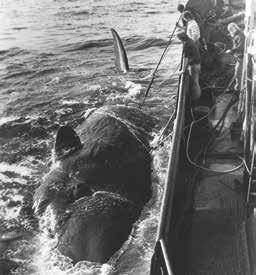

A small band of dedicated people calling themselves Greenpeace was determined to show the world that whaling was inhumane, brutal and unnecessary
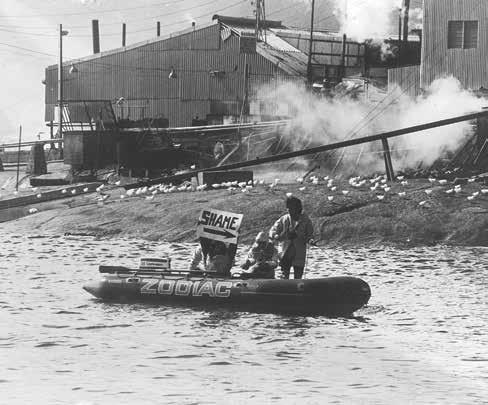
the town was founded. In addition it was still legal, and brought in much-needed money. It was difficult for locals to accept such interference and condemnation from outsiders, in particular activists from as far away as Canada.
While the campaign at Cheynes Beach Station did end, the argument against whaling did not. By the end of 1978, when the Australian government launched a national inquiry, the last whaling station in Australia had already decided to close. It had become the small, isolated stage where tradition had met activism head on and the new issue of conservation had been highlighted. With the last whale oil still in the enormous tanks, Cheynes Beach Station closed with a final season’s catch of 698 sperm whales. It is said that on the last day of operation, 21 November 1978, the crew spotted a bull sperm whale but decided against killing it. Australia had taken a decisive step towards being the most stringent anti-whaling nation on earth.
Cheynes Beach Station is now a renowned whale museum, Discovery Bay’s Historic Whaling Station (see story page 54), and is on the Western Australian State Heritage List. And while life was difficult for the 100-plus employees of the station when it closed, many are now involved in guiding and running the museum. Paddy Hart, master of the whaling ship that went out
on that last day of the station’s operation, is now a strong anti-whaling advocate. He travelled on behalf of Greenpeace to Japan in 2008 in an attempt to assure the Japanese whalers that there is life after whaling.
Today, ships still pursue whales off Albany, but the people aboard them are armed with cameras rather than harpoons. Whales are part of a tourist industry that brings in more than $140 million per year for the region, employs more than 1,200 people and draws more domestic and international visitors than in any other part of Western Australia. With the local whale population growing at an estimated 10 per cent per year, whale watching has become a highly popular attraction. It brings a new type of whale hunter to Albany; those who want to see these animals up close, to hear them and to admire their enormous size and grace. Like the whaling vessels of the past, out to sea the boats still go, waiting and watching for the tell-tale spray from a surfacing whale’s blowhole. And so it is that three decades after Cheynes Beach Station closed, a new whale industry has emerged in Albany.
01 A Zodiac passes in front of the Cheynes Beach Whaling Station, 28 August 1977. Photograph Jonny Lewis Collection, photographer unknown


UNFORGETTABLE EXPERIENCES
Set sail for the voyage of a lifetime aboard one of APT’s luxurious small ship cruises. You will explore the wonders of the world and life at sea when you venture off the main tourist trail. Whether it’s cruising the Kimberley coastline, exploring the coast of Norway or discovering the ethereal Antarctic Peninsula, you will get up close and intimate with the ocean’s magnificent marine mammal; the whale. From humpbacks to orcas, whale watching aboard your luxury small ship cruise is bound to be a truly breathtaking experience, a memory which will stay with you always.
ü INCLUDED – Luxury small group journeys aboard the MS Caledonia Sky, MS Island Sky or Sea Explorer
ü INCLUDED – All shore excursions, sightseeing, tipping, airport transfers and port charges
ü INCLUDED – Exquisite onboard dining as well as wine, beer and soft drink with lunch and dinner on cruise
ü INCLUDED – Zodiac landing craft for a true exploration of remote sights
ü INCLUDED – Guest Speakers or Expedition Team


The Gallipoli campaign of World War I owed much to the efforts of the Royal Australian Navy Bridging Train – the landing of supplies and ammunition, the removal of casualties, and the eventual evacuation of all Allied troops from the Dardanelles. Curator Dr Stephen Gapps and model maker and museum volunteer Geoff Barnes describe the construction of a diorama portraying these ‘bonzer blokes from Kangaroo Beach’.
Geoff Barnes’s diorama depicts in minute detail the 1st RANBT’s work in building wharves in preparation for the Allied withdrawal from the Gallipoli peninsula in Turkey in 1915. Photograph Andrew Frolows/ANMM

THE MUSEUM’S MAJOR EXHIBITION
War at Sea – The Navy in WWI opens in September, in time for the anniversary of the first Australian casualties of the Great War: the Australian Naval and Military Expedition forces at the Battle of Bita Paka in New Guinea on 11 September 1914 and the loss, just three days later, of the submarine AE1 with all hands. Another focus of the exhibition will be the contribution and experiences of the Royal Australian Navy Bridging Train (RANBT). This was the most highly decorated Royal Australian Navy unit during World War I, with 20 awards for bravery or good service at Gallipoli and in the Sinai.
But what was a naval bridging train?
Sailors on horseback
When war broke out in Europe in August 1914 the Royal Australian Navy (RAN) had not long been formed. It had a newly built and commissioned fleet that had only arrived in October 1913, and other vessels
under construction. The RAN was still in a period of transition from the Royal Navy, and many RAN vessels included substantial numbers of Royal Navy personnel who were ‘on loan’ to the RAN. In late 1914, there were Australian sailors in the reserves, but among these only a few immigrant ex-Royal Navy and some ex-Colonial Navy personnel were deemed suitable for active service with the RAN. Most reservists – about 8,000 officers and men – did not qualify to serve on board warships. Many found themselves doing odd jobs such as guarding wharves, practising minesweeping and myriad other minor duties.
Then someone hit on a good idea. Since the reservists were able to sail small training boats, and had some technical training, they should be able to operate pontoon bridging trains. These were wagon-loads of prefabricated bridges, made up of small boats topped with planking that were assembled on the battlefield, usually to span rivers. These were needed urgently by the
Allied armies in Europe, who were short of engineers to do the work.
The 1st RANBT unit was formed in Melbourne in February 1915, and 300 volunteer reservists found themselves with a new career. Many had some maritime and labouring background, but they came from all walks of life, and included an architect, a dentist and a pearl diver. They were a lively mix of youth and experience. But there was an operational problem. Pontoon bridges were carried into action on horse-drawn vehicles, so these sailors needed crash courses in horsemanship as well as engineering and pontoon bridging. They also had to swap their naval uniforms for cavalry khaki. While there were plenty of horses available for training in Melbourne, and the men learned to ride, advanced technical training was difficult in Australia due to lack of equipment and expertise. So the RANBT was loaded onto ships in late May 1915 with the assurance that they could learn more

effectively in training camps in England. They thought they were bound for the Western Front to build bridges across European rivers. But when they got to Egypt, they found themselves conveniently available for a very different campaign and a very different task – to build pontoons in support of amphibious landings in the Dardanelles in the great invasion of Turkey. The RANBT was sent to support a new landing at Suvla Bay. This attack was designed to flank the Turkish forces and support a breakout from the Australian and New Zealand Army Corps (ANZAC) sector, eight kilometres to the south. But the Suvla Bay attacks also failed and turned into a stalemate. By mid-1915, with the Allied forces clinging to beachheads and not in control of any Turkish ports, the RANBT was tasked with building a port.
Lieutenant-Commander Leighton
Seymour Bracegirdle was ideally suited to command the RANBT. Bracegirdle was an inner-city Sydney lad who had served
as a midshipman with the New South Wales Naval Brigade during the Boxer rebellion in China in 1900, and had ridden with the South African Irregular Horse in the Boer War. He joined the brand-new RAN in August 1914, serving as a staff officer with the Australian Naval and Military Expedition Force that captured the German colonies in New Guinea and the nearby Pacific islands, before being appointed commander of the 1st Royal Australian Navy Bridging Train.
Bracegirdle chose his volunteers carefully. Many were fellow veterans of the New Guinea campaign. Bracegirdle was to show a great capacity to adapt the RANBT’s particular skills and personalities to the situation at hand.
Early on the morning of 7 August, the RANBT landed at Suvla Bay under accurate Turkish artillery fire. The train set about building a pontoon pier to enable
Crates, sacks, sandbags, water tanks, light rail track and bogies, cables, ropes and all manner of abandoned junk littered the landscape of Suvla Bay
01 The central figures are building wooden ‘cribs’– wharf supports which, during the evacuation, would be floated out into the bay to create wharf decking. The diorama’s cribs are balsa, scaled to fit the perspective. Photograph courtesy Geoff Barnes
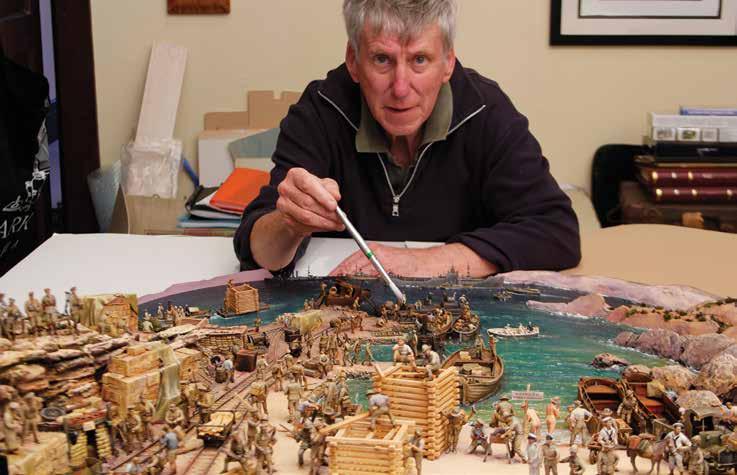
desperately needed supplies to be brought ashore, and casualties to be evacuated. This was their first vital contribution amid the shambles of the ill-planned and poorly led campaign. The RANBT set up their camp in a little cove that became known as Kangaroo Beach, just around from the main harbour at West Beach. This was where they worked on an incredibly diverse variety of tasks.
They built wharves and piers. They unloaded the work-boats that used them. They repaired the wharves and piers when storms tore them apart, or when the Turks blew them up, or when over-excited or careless coxswains crashed their vessels into them. They were instrumental in designing pumping and piping systems for getting vital water supplies ashore from the ill-designed lighters. Ingenuity was the key. They repaired and stockpiled engineering equipment that might otherwise have been discarded. They cobbled together whatever was needed in their open-air workshops on the beach. They did all the assorted jobs that the Royal Navy and the British Army were ill equipped or reluctant to do.
With the inevitable withdrawal from the Dardanelles in late 1915, the Allied forces faced the difficulties of safely extricating more than 100,000 men before the Turkish forces realised what was happening and wiped them out. Painstaking efforts were taken to make the Turks think that the British were building up for another offensive rather than a withdrawal.
The RANBT began to build wharves as prefabricated units on the beach, in full sight of the Turkish forces up on the hills, in the hope that the Turks would think they were being built to land more troops. Once built, the wharves were shipped to locations out of sight of Turkish positions. Certainly, by late December the Turks had not realised that the Allies were planning to abandon the Dardanelles in secret.
Most of the RANBT had evacuated under the cover of night by 17 December, but a small team remained on duty until the British rearguard and senior officers had boarded the last of the lighters. The last Australian infantry left Anzac Cove at 0410
hours on 20 December 1915. Only then did the last of the RANBT leave, at 0430 hours.
So the RANBT were instrumental in building the piers for the evacuation – a withdrawal that proved to be the most successful part of the whole tragic campaign.
The scene that Geoff Barnes has re-created in his diorama is a view of the activities of the 1st RANBT while building the wharves in preparation for the Allied withdrawal.
Geoff wanted to make the diorama as historically accurate as possible, and to get the colour and atmosphere right. His work was based on extensive research of the RANBT, as well as books on uniform details, works of contemporary artists and personal accounts. He also gathered many photographs of what the landscape and terrain were like both then and now.
His most important resource was the portfolio of photographs taken in 1915 by Lieutenant-Commander Bracegirdle to document the work of his troops at Suvla
The design of the diorama was based on extensive research of the RANBT, books on uniform details, works of contemporary artists, personal accounts, and photographs of the landscape and terrain
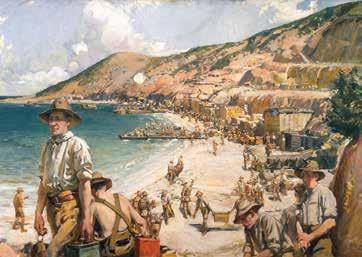

Bay. These candid photographs were taken with an engineer’s eye for detail. They were not official military photos – censorship forbade photography except by sanctioned cameramen. Despite this, many young officers packed a Kodak folding camera in the voluminous pockets of their tunics.
The diorama is 1.5 metres wide by 1 metre deep, and took eight months to complete. It comprises an extensive landscape piled high with military materials, a harbour sheltering 19 vessels – all built from scratch – and about 160 individual figures. Some of these are metal, but most are from plastic ‘kit figures’ that have been converted to accurate representations of the RANBT uniforms. All of these elements range in scale from 1/35th to 1/500th.
Forced perspective is the key to this diorama. If viewed from the front, the figures and landscape diminish into the distance accordingly. This led to some interesting problems and no easy solution. Geoff often had to judge by eye as he went, and keep grafting the balsa-wood hulls of vessels until they looked right.
The key component here is the light rail line that leads from the foreground to the distant wharves. Geoff used three different gradings of plastic girder, diminishing the rails and their underlying sleepers to create the impression of distance.
Much of Geoff’s materials were bits and pieces collected over 50 years of modelmaking. He used some 54-millimetre Anzac character heads from Queensland sculptor Phil Walden, plus commercially available figures from Airfix, Tamiya, Mini Art, Master Box and Sveda, and railway modelling and ship model-making supplies. He found Scale Link’s range of World War I heads with their distinctive slouch hats and sun helmets – as well as a wide range of weapons, webbing and useful accessories like water cans and wheelbarrows – to be invaluable.
Geoff began by laying out the diorama in full size on a large sheet of cartridge paper. It would change over the months to come, but on completion, was more or less as he had conceived it. He did card mock-ups of the landscape features and cut-outs of the ships’ shapes.
01 Geoff Barnes with his almost-completed diorama, which will be a centrepiece of the museum’s forthcoming exhibition War at Sea – The Navy in WWI. Photograph courtesy Geoff Barnes
02 The beach at ANZAC by Frank Crozier (1919). Geoff Barnes used this image as a colour reference for his diorama. Frank Crozier was later appointed an official war artist. He was one of the few official artists who had experienced heavy fighting, at Pozières and also at Gallipoli. Crozier often depicted the soldier’s viewpoint and painted the human dimension of warfare. Australian War Memorial ART02161
03 West Beach, Suvla Bay, Gallipoli, in 1915, photographed by Lieutenant-Commander Leighton Seymour Bracegirdle RAN, commanding officer of the 1st Royal Australian Navy Bridging Train at Gallipoli. Australian War Memorial P11165.010.001
01 The ‘black beetle’ landing craft were scratchbuilt from filing card shaped around balsa wood hulls. The vessels had to be tapered to create the impression of diminishing perspective, and figures of different scales were placed on the decks to reinforce the illusion. Photograph Andrew Frolows/ANMM
02 Varying flesh tones were applied on faces and hands, reflecting differing skin tones and degrees of suntan or sunburn, as well as bruises and injuries. The RANBT sailors used to collect fish that had been stunned by Turkish shells bursting near the docks – a vignette reproduced in the diorama.
Photograph Andrew Frolows/ANMM
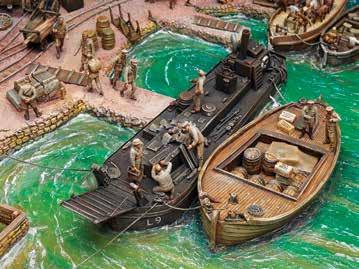

The diorama started with a light but sturdy framework of pine. The landscape was then built up with 3-millimetre medium-density fibre board, which can be easily sawn or cut with heavy-duty craft knives. The distinctive rock strata were layers of pine bark from a treasure trove of useful odds and ends belonging to Geoff’s long-time modelling mate Bob Metcalfe.
The groundwork is builders’ sand, coarser than beach sand, mixed with spackle-type wall filler, PVA glue, student paint and water. Geoff has a large variety of various grades of sand and gravel stored away in jars, and these were added depending on the required texture of particular groundwork.
The 300 volunteer reservists of the 1st RANBT unit came from all walks of life, and included an architect, a dentist and a pearl diver
Groundwork colours are artist acrylics applied with heavy-duty bristle brushes made for large-scale oil painters. Shadows, and shading, are clearly identifiable in the contemporary work of war artists. Along with a paynes grey and alizarin crimson mix, a lavender colour – not familiar in European shadows – is very distinctive and reflects the harsh Turkish sunlight.
Geoff’s constant companions during the project were air-drying clay, paper clips, PVA – of which he used five large bottles – Araldite, super-glue, plastic card and cartridge paper. The household vacuum cleaner and a pensioned-off hair dryer were also most useful.
The historical photographs show piles of supplies everywhere. Crates, sacks, sandbags, water tanks, light rail track and bogies, cables, ropes and all manner of abandoned junk littered the landscape of Suvla Bay. Geoff plundered his ‘bits boxes’ for anything that could pass as military rubbish.
A laborious task was to re-create the lettering on the ration boxes. Geoff made shapes in general proportion, and then pasted box fronts on them, with labels such as those for the much-loathed bully beef made in different sizes to fit the diorama’s forced perspective.
The photographs of West Beach all showed tantalising glimpses of landing craft, but none had sufficient detail. Geoff searched for references and found that the ships’ lifeboats and barges that were towed over from the Nile River in Egypt were insufficient to keep up the massive daily consumption of water, food, ammunition and supplies. With some foresight the Admiralty had commissioned 200 landing craft (dubbed ‘black beetles’) – long, motor-driven barges with spoon-shaped bows that could be easily run up on to beaches, and which had drop-down ramps to facilitate unloading.
Most of us know World War I in monotone, from black and white photographs and film footage. So Geoff sought out soldier–artists who had done on-the-spot paintings, or war artists who had researched the campaigns with an eye to detail.
Frank Crozier was an ANZAC at Gallipoli, and had been a promising artist before joining up. While at Gallipoli, he was approached – along with other artist–soldiers – by Charles Bean and asked to help illustrate Bean’s proposed The Anzac Book, a collection of poems, short stories and illustrations by the soldiers at Gallipoli.
Crozier’s large painting of Anzac Cove, showing men, material and landscape in glowing colour, was a prime resource for the diorama. So too were the works of British sailor Norman Wilkinson, who served in the Royal Naval Volunteer Reserve in the Dardanelles and was an artist of note (he also invented ‘dazzle camouflage’ for ships). Wilkinson’s luminous watercolours of Suvla Bay in 1915 provided further on-the-spot colour references.
After eight months of painstaking work, Geoff’s diorama was complete. It will now be installed in a display case and form a central interactive experience in the exhibition War at Sea – The Navy in WWI The exhibition will be on display at the museum from September this year until May 2015, after which it will travel to various regional museums around Australia.
A more detailed account of the creation of the diorama can be found in Military Modelling Vol 44 Nos 2 and 3.
The official war correspondent with the Australian Imperial Force, journalist and honorary captain C E W Bean, wrote of the RANBT at Suvla Bay: There they are in charge of the landings of a great part of the stores of a British army. They are quite cut off from their own force; they scarcely come into the category of the Australian force, and scarcely into that of the British; they are scarcely army and scarcely navy. Who is it that looks after their special interests, and which is the authority that has the power of recognising any good work that they may have done, I do not know. But if you want to see that good work, you only have to go to Kangaroo beach, Suvla Bay, and look about you. They have made a harbour.
In the 1920s a series of dioramas was constructed for the Australian War Memorial in Canberra. The idea for the dioramas came from discussions between C E W Bean and a group of war artists. Bean saw the dioramas not just as battlefield models, but also as works of art and educational displays. The dioramas – once regarded as dusty remnants of an old way of viewing the past – are now among the prized treasures of the Australian War Memorial.

The Australian Register of Historic Vessels went on the national beat in November last year, with a seminar in Western Australia that canvassed the state’s historic vessels, the trades they plied and the people involved with them. Conference organiser, senior curator Daina Fletcher, relates some of the tales that emerged.
W ESTERN AUSTRALIA’S MARITIME STORY is dominated in the popular imagination by two major themes: the 17th- and 18th-century Dutch navigators shipwrecked on inhospitable shores, and the triumph of Australia II in the 1983 America’s Cup. But the many other histories woven between these events and eras are just as compelling. They also offer different perspectives on the economy of this huge state beyond what can be mined from it or grazed upon it.
The Australian Register of Historic Vessels (ARHV) seminar held in Fremantle last November was titled Fishing, pearling, sailing or trading: stories of Western Australia’s seagoers and their craft. Its aim was to explore these industries and the economics and communities that shaped and sustained them.
A deliberate strategy was the pairing of theoreticians with active participants across a range of themes. Our audience listened to first-hand accounts alongside analytical historical presentations on such topics as fishing, pearling, Aboriginal coastal culture, and sailing. In each case, the theory and practical aspects of history were woven around craft on the ARHV so that each session encompassed both the public and the personal, the general and the specific, to add depth and context.
The seminar was introduced by Moya Smith, Head of Anthropology and Archaeology, and Brett Nannup, Indigenous Collections Registrar, both from the Western Australian Museum (WAM). They explored the coastal and riverine cultures of Western Australia’s Aboriginal people from their relative perspectives – Moya as an anthropologist who has worked with saltwater peoples from the Kimberley, and Brett as an artist and member of the Pinjarra community south of Perth, who has fished and hunted in his country for much of his life.
Moya showed an engaging range of images that emphasised continuing traditions, from rock art to more recent early European documentation. These included the barrawarra – a generic term for canoes, but commonly used to describe simple dugouts; namandi, bark canoes with additions; and galwa or biyal biyal, single or double fan-shaped rafts made of kapok mangrove, examples of which are in the collections of both WAM and ANMM.
While Moya covered coastal Kimberley water-based traditions of the north-east, Brett Nannup told us of his life by the water in the south-west, especially of fishing as a source of contentment and contemplation. Brett is a printmaker who also makes artefacts such as spears using traditional techniques. His lyrical exposition featured his prints and related his family stories of fishing, and favourite childhood fishing spots along the Canning and Murray rivers.
Aboriginal fishing along rivers, estuaries and the coast has been practised for millennia, and is small in scale. Other speakers at the seminar traced the involvement of saltwater peoples in the fishing and pearling industries as these industries grew, with seals, whales, bêche de mer, fish, crays, shell and pearls becoming valuable commodities for overseas export. Aboriginal people worked as highly skilled divers, fishers, boatbuilders and crewmembers.
The development of fishing as an industry was addressed by Professor Malcolm Tull of Murdoch University, who outlined its changing scale from small beginnings as a family activity in the early years of the Swan River colony from the mid-19th century, to its growth with the construction of the Great Southern Railway between Albany and Perth in 1889 and of the ice-works in Albany in the 1900s. The ice-works enabled the industrial packing of fish for transport to markets along the rail line.

After World War II, European immigrants brought their tastes and traditions to Western Australia, and saw the huge potential in the rock lobster and prawn fisheries
01 Hauling salmon at Hopetoun on the south coast of Western Australia, in the late 1940s. J S Battye Library. Reproduced with permission
02 Beth Fitzhardinge with crayfish, c 1964. Photograph courtesy Fitzhardinge family


The industry had its challenges – the infrastructure was limited, while costs remained high and fish populations and productivity low, as fish lost out to beef on Australian dinner plates. Industries on the land offered more opportunities for wealth than those from the sea, and the small and scattered population provided limited numbers of entrepreneurs willing to enter the fishing industry. It remained small.
Innovative 3D laser surveys conducted to millimetre accuracy are a brilliant resource for rebuilding a craft, documenting its current condition and imagining its future and past configurations
Things changed after World War II, when European immigrants brought their tastes and traditions to Western Australia, and saw the huge potential in the rock lobster and prawn fisheries. This, with the adoption of new technologies in the 1960s, transformed
the fisheries into a valuable export industry. The Kailis and Lombardo families became Western Australia’s first millionaire fishers, and high-value fisheries were established in the Exmouth Gulf and Antarctica.
Fish stocks were assaulted, yet Malcom Tull asserted that the introduction of management controls in the 1960s ensured that the industry remained sustainable, and in 2000 it was the first fishery in the world to be certified as ecologically sustainable by the Marine Stewardship Council. Western Australia’s share of the nation’s fishery value has dipped in response to the rise of the aquaculture industry in South Australia and Tasmania, which employs 13 per cent of Australia’s fishing workforce.
The less commercialised side of the industry was no less significant, especially to regional Western Australia. This consisted of small-scale family fishers centred around Geraldton and working the Abrolhos Islands crayfishery. They fished seasonally for months each year, forging a tight-knit community that built schools and churches on the islands for their sail-in, sail-out lifestyle – an earlier incarnation of today’s fly-in, fly-out workers.
The next speaker, John Fitzhardinge, was one of these Abrolhos Islands fishers. He started his fishing career at the Geraldton Fisherman’s co-operative in 1961, and the
next year built his own 24-foot (7.5-metre) fishing boat with his fiancée Beth. This seakindly craft had an innovative, bondwood hard-chine planing hull, which was by then a staple of the competitive industry.
John and Beth entered the industry at the end of its ‘gold rush’ period. The following season the industry was closed at 826 boats, then further restrictions were imposed on the number of pots – three – that were allowed per foot (30 centimetres) of boat length. In addition, the fishing grounds were closed from 30 June to 15 November to protect the breeding females.
The lifestyle was basic. John and Beth started their married life in a corrugated iron shed with a sandy floor, which was buffeted by any south-easterly breeze. They collected their water in tanks or carted it from Geraldton in carrier boats that also brought their stores, bait, fuel, water, building materials and mail once a week.
Before the school was built in the late 1960s, families were together only in the holidays. At other times they kept in contact by a rudimentary radio service, which relayed weather reports, telegrams and the weekly highlight of the fishermen’s request program (with dedications), sponsored by a Geraldton commercial station.
Communications improved with reliable radio, airstrip construction and eventually
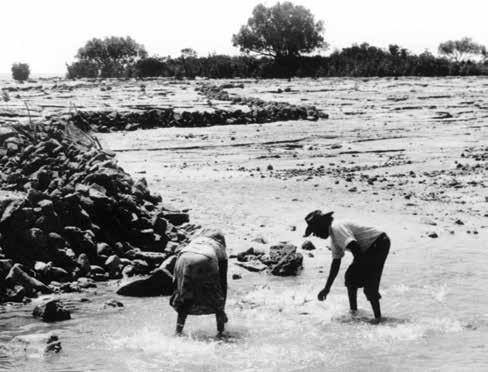
television. Similarly, medical services were initially do-it-yourself in an industry which, according to John, was pretty unhygienic in the early days, and there were no freezers and inadequate protective clothing. By the 1970s most fisherman had freezers on the jetties they had built, and a weekly nursing service was established.
Fitzhardinge’s community at North Island built a school and employed teachers, allowing families to stay all season. It also built a hall, held fancy-dress and sports days and operated a bar every night. The community gradually grew to 130 people, including 25 primary school students and two teachers.
The unique sail-in, sail-out lifestyle that the Fitzhardinge family knew is disappearing, and cray numbers are falling. Malcolm Tull notes that the fishery has been influenced by environmental factors such as weather cycles, wind patterns and water temperatures – for instance the strength and temperature of the Leeuwin Current – plus the growth of recreational fishing in general.
The catch is dropping and new management regimes have reduced the Abrolhos fishing fleet and changed its operation. Many fishermen cart their own crays; only two carrier boats now operate in the island group; only one social club remains; and the last school, on Big Pigeon Island, has closed.
While the fishing industry is commercially important to Australia and represents an adventurous, unique lifestyle, perhaps the most fascinating Western Australian fishery was pearling, which had its boom period long before fishing was commercialised.
In 1913 it was the highest export earner for the state, as Michael Gregg from the Western Australian Museum pointed out in his talk about the state’s pearling history, which peeled away the romance of the industry to focus on its diversity.
The crews were famously culturally varied, comprising Indigenous divers and crews in the early years, then Indonesians, Malays, Filipinos, Japanese and Chinese. In fact the pearling port of Broome was exempted from the White Australia policy of the early 20th century because of its reliance on foreign workers.
Diversity in place, land and seascape also characterised the industry, from the Shark Bay pearl fishery to the north-west shellfishing ports of King Sound, Darwin and the Arafura Sea, and Torres Strait and North Queensland in the Gulf of Carpentaria. These different places and environments spawned different boats: shallow-draught flat-bottomed luggers of the tidal Western Australian coastline and the deeper-keeled designs of Thursday Island and the Torres
01 When Dad used to take us fishing at the Bend, by Laurel Nannup. Image courtesy Brett Nannup
02 Dugout canoe with a Culwulla Jawi crew member paddling near Bigge Island, Western Australia. NW Scientific Expedition, 1917. Photographer William Jackson. Image courtesy Western Australian Museum
03 Bardi elders Esther and Sandy Paddy, with 60 trevalley caught in Lalanan fishtrap, near One Arm Point, Western Australia, 1983. Photographer Moya Smith. Image courtesy Western Australian Museum
Strait. The boats also operated differently. In Torres Strait they stayed at sea for longer, working in deeper water, where their more yacht-like designs made them more manoeuvrable. The Broome fleet, by contrast, worked in 10-metre tides and, during the cyclone season, had to dry out on secured moorings or be purposely run aground on river beds for safety. The ARHV features 14 luggers, including several Broome luggers such as the DMcD, built in 1957 by Streeter and Male, who also built the ANMM’s John Louis
Michael outlined technological changes which affected lugger design and their raison d’etre – to provide air to divers collecting shell on the sea floor. These ranged from hand-operated, then enginedriven, air pumps on board to the combination of the propelling engine and the compressing engine, which could both drive the ship and support the diver at the same time.
Tony Larard is a former diver and small-scale pearl fisher who worked in the industry in the 1980s and 90s. He offered his personal perspective on operating such a business and the life it entailed. He entered the industry after another technological leap – the hookah diving technique, in which divers drifted in lines two or four deep, supplied with surface air, towed on outriggers from the ship.
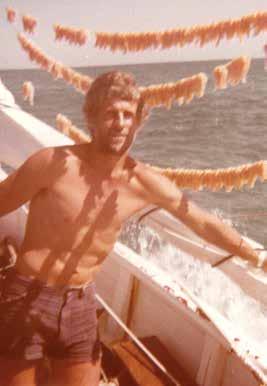

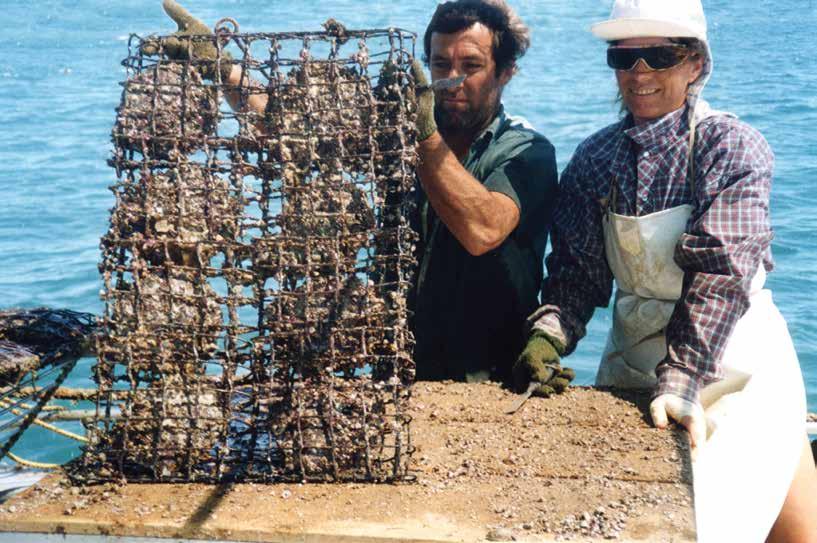
This method – the biggest change to pearl diving since the introduction of the airsupplied hard-hat suit – was introduced to Broome in the 1970s by South Australian abalone divers.
Tony’s first venture was for pearl shell in 1980, when he took his lugger Intombi, built in 1928, north to the Onslow area. Excited about the potential, he built another vessel, Willie, to enter the new pearl farming industry.
The Western Australian pearling industry had its boom period long before fishing was commercialised, and in 1913 it was the highest export earner for the state
Tony spoke in detail about the vessel and everyday life on a pearl farm – fishing, collecting shell, depositing it in the dump at sea, cleaning it and taking it to the farm to be spread on the bottom until the Japanese technician arrived to seed it. After implantation the shells were placed on the bottom and regularly turned for a six-week period, then put on surface longlines. There they remained until the pearl matured in two to three years. Before harvest, they were X-rayed; those carrying 12-millimetre pearls were opened, the pearls removed, then the shells reseeded if healthy. Shells with immature pearls would be returned to the lines for another year.
For nearly a decade, the entire family spent their lives between sea and land – living and fishing on the boat during the neap tide, and back at the farm base on West Moore Island on the spring tide. It was hard work and Tony was quick to accept an offer to sell the business. Today the cultured pearl industry is dominated by large multinational firms and the Paspaley family.
The ARHV at work
A session on the ARHV at Work gave voice to several owners whose vessels are listed on the ARHV, and highlighted the register’s
potential for enabling collaborations between owners and register staff in both sharing information and working together on methodologies and tools for historic vessel management.
Ron Lindsay outlined his passion of more than a decade: to save the 100-year-old, 40-foot (12-metre) motor launch Kiewa, which had been built by W and S Lawrence, his great-grandfather and great-uncle, for the commodore of the Royal Perth Yacht Club. Mike Beanland, owner of the double-ended Swan River ferry MV Perth, told of his often frustrated efforts to preserve and secure the 103-foot (31-metre) vessel. These ranged from spraying herbicide to unwrap weeds from the vessel to an innovative 3D laser survey conducted to millimetre accuracy. This is a brilliant resource for rebuilding a craft, documenting its current condition and imagining its future and past configuration. A 3D survey can be smoothed out, played with, changed to something different – it is a fantastic way to record historical artefacts, including buildings, and to interpret them.
ARHV council member Dr Ian MacLeod presented a beautiful exposition about conservation principles, while ARHV curator David Payne outlined Western Australian craft on the ARHV, which now total 36.
The final event of the day was the Vaughan Evans memorial lecture, jointly hosted with the Australian Association for Maritime History. Sailor and Western Australian businessman John Longley am c it wa delivered an engrossing behind-thescenes history of the America’s Cup, from Australia’s II’s historic win 30 years ago to the current contenders, and throwing further light on that landmark vessel and the people bound up in its significance.
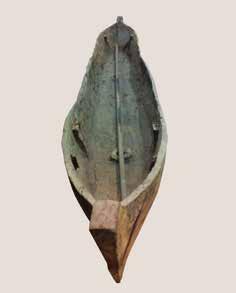
This seminar was planned at an important time for the Australian Register of Historic Vessels (ARHV). Now in its eighth year, the register’s website arhv.gov.au is soon to have a much-needed facelift and redesign. Today the ARHV includes entries on 548 boats of all types: recreational, commercial, naval and Indigenous vessels, from all around Australia and overseas. There are also 102 reference entries, on builders, designers, types, classes, events and sites, plus more than 3,000 images, 130 plans and various multimedia entries (see Signals 105).
01 Tony Larard on the lugger Intombi in 1980 with pearl shell meat drying from the rigging.
02 Ross and Dianne Larard in 1997 with a harvest of round pearls.
03 Eve Adams and a deckhand cleaning pearl shell in 1996.
All photographs courtesy Eve and Tony Larard
04 Dugout canoe made by Robert Cunningham, Iwaidja, before 1970. Collected at Cobourg Peninsula, Northern Territory. Photographer Moya Smith. Western Australian Museum A23786
The ARHV was initially conceived as a cultural mapping program to chart Australia’s historic craft, to find out where they are and what they have meant to communities and history. Today the rich stories of the boats on the register and the opportunities offered by analysis of the industries or practices they represent, in seminars such as this, allow us to ask important questions about the comparative significance of those craft nationally. For example, how does the development of the fishing industry in Western Australia relate to that in South Australia, and how do surviving vessels reveal this? Is one more important than the other? These questions and many more will inform the next stage of the ARHV’s development, along with considerations of rarity, representativeness, original material, preservation, interpretive potential and possibly project sustainability.
The seminar was a great success, and we hope that this will be the first of many programs developed in association with museums and organisations around the country as the ARHV goes well and truly national.

European settlers in New South Wales soon found the local timbers to be excellent for shipbuilding, and their qualities were quickly recognised in Britain also, resulting in a thriving colonial shipbuilding trade. Architectural historian and researcher Dr Roger Hobbs traces some of the earliest records of this industry, and examines the timbers that were favoured.
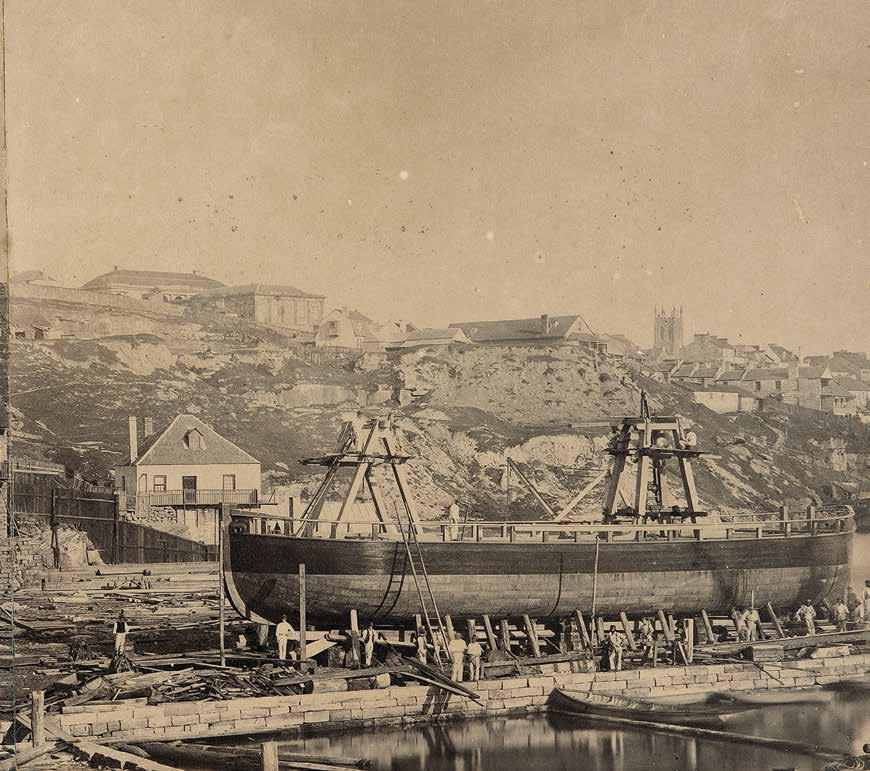 John Cuthbert’s shipbuilding yard on the western shore of Miller’s Point, Sydney, in the early 1860s. ANMM Collection
John Cuthbert’s shipbuilding yard on the western shore of Miller’s Point, Sydney, in the early 1860s. ANMM Collection
IN 1802, JOHN HUNTER, second governor of New South Wales, wrote to British Under-Secretary John King:
Dear Sir …
The crooked limbs of most of the gumtrees, when sound, are very fit for ship timbers or ribs, and are uncommonly durable … Masts have been made of it … When this wood has been used for planking a ship, it has been found of so hard a nature that a scraper would hardly touch it (Cornhill, No 40, 22 March 1802)
This complimentary assessment of Australian native timbers was made just 14 years after the colony of New South Wales was established. The selection and use of any timber was based on its strength, durability, straightness of grain and resistance to marine borers, a process which had begun with the arrival of the First Fleet in New South Wales in 1788. Shipwrights and boatbuilders, appointed by successive governors in Sydney, had, by 1803, identified mahogany, stringybark, honeysuckle, ironbark, box and red, black (blackbutt) and blue gums as suitable for shipbuilding. However, the first detailed description of the timbers used in colonial shipbuilding is that of the Australian, a whaling vessel of 270 tons burden, launched on the Hawkesbury River near Pitt Town in March 1829, written by its builder Captain Grono:
The outer planking of the Australian is 2 inches [5 centimetres] thick, each plank being from 10 to 14 inches [25 to 35 centimetres] wide. She is chunamered , or covered with a coating of oil and lime,
after the manner of the Chinese Junks, and is sheathed over all: the masts and yards are of black-butted gum, and have been already procured, though not shipped. The whole of the materials from stem to stern, and from keel to truck, consist of blue gum, black-butted gum, iron bark or apple tree ... The knees and timbers are of iron bark, and the top timbers are of apple tree, most of which were procured from Pitt Town Common (The Sydney Gazette and New South Wales Advertiser, 2 April 1829, p 2)
The value of Australian timbers was recognised by marine insurers Lloyd’s of London by 1851
During the period 1843–1856 alone, 351 new vessels built in the colony were registered in Sydney. Almost all were for the expanding coastal and intercolonial trade out of Sydney, with the majority built in the northern coastal districts. Almost without exception, these vessels were built for and by the merchant sector, which reported the materials used in construction in the newspapers of the day, as evidence of the quality and safety of their new acquisitions. Colonial vessels such as these have left little but archaeological evidence of the timbers used in their construction. However, a case of timber samples,
used in ship and boat building in New South Wales in the 1860s, has survived in the collection of Museum Victoria, Melbourne. Assembled by respected Sydney shipbuilder John Cuthbert for the Intercolonial Exhibition in Melbourne in 1866, the representative samples were listed as:
1 Blue Gum; 2 Red Gum North; 3 Red Gum South; 4 Water Gum; 5 Spotted Gum North; 6 Spotted Gum South; 7 Iron Bark; 8 Black Butt; 9 Blood Wood; 10 Bang Ally; 11 Iron Bark (40 years in use); 12 Stringy Bark; 13 Mangrove; 14 Colonial Beech; 15 Colonial Pine; 16 Mahogany (27 years in water); 17 Swamp Mahogany; 18 Swamp Oak; 19 Kauri Pine; 20 Cedar; 21 Forest Mahogany; 22 Myall; 23 White Honeysuckle; 24 Red Honeysuckle; [25–26 labels missing, although one may be Mountain Oak]; 27 Bean Tree; 28 White Tea-tree; 29 Tulip; 30 Native Pear Tree.
John Cuthbert (1813–1874) was born in Cork, Ireland, and apprenticed to a shipwright. He arrived in Sydney in 1844, and by 1853 had taken over Corcoran’s shipyard, later moving his business to Millers Point. Cuthbert’s business carried a stock of seasoned timber, which in 1868 included, for framing and planking, ‘the ironbark, blackbutt, and the flooded, blue, red, and spotted gums; and, for fittings, the tea tree, ironbark, blackbutt and bangalley’. The stock of timbers fits well with the timbers described in the Empire in 1857:
The durability of many kinds of Australian timber, and its superior qualities for naval purposes, have … only lately been acknowledged at Lloyd’s. A vessel framed out
Built Date
Richmond River, Coraki 1876 Beagle
Three-masted schooner, screw-steamer 170 tons, LOA 150 feet (45.7 metres): keel ironbark, frames hardwood, beams box. Top timbers cedar, planking inside and out spotted gum and blackbutt
Williams River, Hunter River catchment 1832 Unnamed Schooner, 62 tons, LOA 48 feet (14.6 metres): floor timbers ironbark, first futtocks flooded gum, top timbers flooded gum and cedar, outside planking flooded gum, decks pine (unconfirmed) to an American design
Brisbane Water 1865 Cleone Ketch, LOA 70 feet (21.3 metres): keel, keelsons, timbers of ironbark, beams of blackbutt, planking of blackbutt, decking colonial beech
Sydney 1872 Eglantine
Armed schooner, LOA 77 feet (23.5 metres): keel of ironbark, framing of blackbutt and blue gum with kauri pine for the planking (one of four in a government contract)
Jervis Bay 1867 Duke of Edinburgh Barque 358 tons: framing ironbark, planking blue gum, keelsons ironbark, decks kauri pine
Clyde River 1866 Vision Brig, LOA 105 feet (32 metres): framing ironbark and red gum, planking and ceiling spotted gum, decks kauri pine
01 A box of Australian timber samples exhibited by John Cuthbert at the 1866 Intercolonial Exhibition in Melbourne. An article in The Argus on 25 October 1866 stated, ‘an enormous fund of information is to be found in a case shown by Mr J Cuthbert, ship-builder of Sydney, which contains thirty miniature beams, which can be taken out and handled’.
02 Labels from the box of Cuthbert’s samples, identifying the timbers within.
03 An advertisement for Cuthbert’s shipyard attached to the box of timber samples. All images reproduced courtesy Museum Victoria

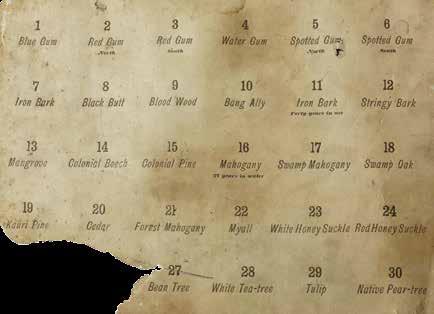

In newspapers, merchants reported on the materials used in construction of their new vessels as evidence of their quality and safety
of ironbark, box, red honeysuckle or tee tree, and planked and lined with flooded gum, blue gum or blackbutt; and treenailed with iron-bark, will receive the very highest class given, provided Lloyd’s rules with regard to timbering, planking, shifting and fastening be otherwise attended to.
A strong merchant-trade with Britain, coupled with shipments of Australian timbers to shipyards in both Britain and India, resulted by 1851 in recognition of the value of Australian timbers by marine insurers Lloyd’s of London. The Australian Lloyd’s Association, formed in 1864 in Melbourne, classified the timbers to be used in its Rules and Regulations, which encapsulated existing colonial shipbuilding standards. This source, coupled with newspaper reports of vessels, such as those tabled on page 24, has enabled a core group of indigenous timbers to be identified and the species and uses of Cuthbert’s samples to be explored.
The core indigenous timbers used in New South Wales in the 19th century were flooded gum Eucalyptus [E.] tereticornis, blue gum E. saligna, blackbutt E. pilularis and ironbark E. paniculata, all of which were represented in Cuthbert’s samples. Regional construction standards were influenced by the timbers available, however, including many in Cuthbert’s samples, although an ironbark keel was almost standard.
Ironbark was mainly used for the timbers, floors and keels of vessels. The common or she-ironbark E. paniculata, now known as grey ironbark, was also used for planking; timber from this tree was ‘prized by the shipwright’, and was also used for knees. The large-leaved ironbark E. siderophloia, now known as the northern grey ironbark,
indigenous
was not correctly described until 1867, but is thought to have also been used for large, sectional timbers such as keels. Cuthbert’s ironbark samples have still to be identified.
The flooded gum or red gum E. tereticornis, used for heavy deck-framing, beams and knees and planking, is now known as the forest red gum. The closely related and allied red gum or river red gum E. rostrata, now E. camaldulensis, found only in the catchment of the Hunter and Goulburn rivers in the coastal districts, was identified as a new species in 1847. In 1868, Cuthbert’s stock included both flooded gum and a ‘red gum’, suggesting that his northern red gum sample could be the red gum E. rostrata – although both red gum samples, based on current standards, may be the flooded gum E. tereticornis
The flooded gum E. tereticornis should not be confused with the flooded gum E. grandis, identified as a separate but related species to the blue gum E. saligna in 1862. The blue gum, used for framing and planking, was also known by the common names grey or flooded gum. The flooded or rose gum E. grandis, which grows in and north of the Hunter River district, was used for masts and planking. Similarly, blackbutt E. pilularis ‘grew to a great height’ and was ‘well adapted for masts’, for which it was in use by the 1820s as well as for planking. Used for many purposes, blackbutt was seen in 1885 as ‘ranking in durability next to the far-famed ironbark’.
Stringybark E. obliqua, also known as messmate, had an indifferent reputation for shipbuilding, being used for framing in protected areas and not considered suitable for outside planking. Spotted gum was used increasingly in the 1860s for
Mid-19th-century common name Other/Latin names, and year first described Modern names
Flooded gum Red gum, blue gum or grey gum Eucalyptus [E.] tereticornis 1795
Forest red gum E. tereticornis
Blue gum Grey gum or flooded gum E. saligna 1797 Sydney blue gum E. saligna
Blackbutt Black-butted gum E. pilularis 1797; ironbark E. persicifolia 1822
Ironbark Common, she or red ironbark E. paniculata 1797
Blackbutt E. pilularis
Grey ironbark E. paniculata

01 Timber getters near Yarrowitch, northern New South Wales. Courtesy State Library of New South Wales
02 Tallow-wood log on a jinker drawn by A A Teague’s bullock team at Warrell Creek, New South Wales, c1905. Reproduced courtesy Macleay River Historical Society 01
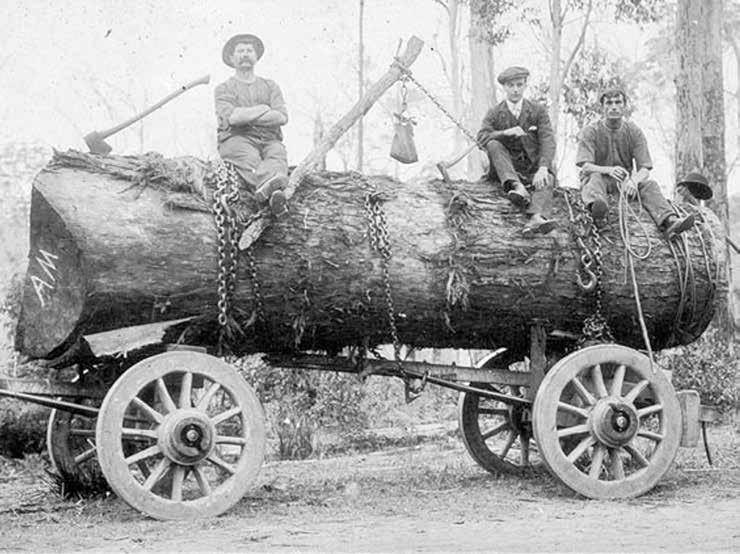
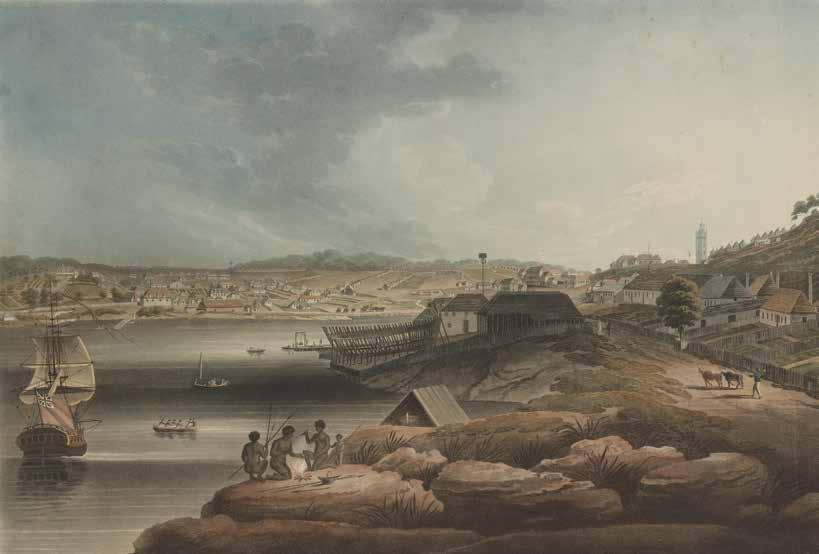
Colonial vessels have left little but archaeological evidence of the timbers used in their construction
timbers such as keels and keelsons and for planking in ships’ bottoms, due to its capacity to bend; by the end of the 19th century it was considered as good as English oak. The southern sample in Cuthbert’s selection is E. maculata, now Corymbia [C.] maculata, found throughout the central and southern coastal districts; the northern sample is the large-leafed spotted gum C. henryi, found in northern New South Wales. The related bloodwood, probably C. gummifera, was used infrequently for framing and planking.
Mahogany E. resinifera, a hard, heavy, durable timber, was used for knees and framing in vessels. Similarly, swamp mahogany E. robusta was also employed for knees. Not as durable as other timbers, it was increasingly used for heavy framing in coastal vessels. Bang ally or bangalay E. botryoides, known as bastard mahogany, was used for the ‘knees and crooked timbers of vessels’ and was considered an ‘excellent timber for the shipbuilder’.
The forest mahogany or tallowwood E. microcorys, ‘eagerly bought by the shipwright’ in the 1870s, was used increasingly for framing, planking and fitting-out by the end of the 19th century.
The white tea tree Melaleuca leucadendron (now M. leucandendra) was available throughout the coastal districts. Sought after for its hard, close-grained wood, white tea tree was used for framing, knees and fittings in all types of coastal vessel. Re-classification has limited the distribution of M. leucandendra to Queensland and other northern regions; M. quinquenervia is the revised species name in New South Wales.
Although colonial hardwoods were used for masts and spars, local and imported pine timbers were also used, as well as for decking. Kauri pine, imported from New Zealand, was commonly used for decking, although also for planking, masts and spars. The colonial pine or hoop pine Araucaria

01 A view of Sydney Cove, New South Wales, 1804. Drawn by E Dayes from a picture painted at the colony. Hand-coloured aquatint engraved by Francis Jukes, depicting a timber vessel on the stocks. National Library of Australia.
02 Spitfire, Australia’s first warship, was designed and built by John Cuthbert in 1855 from ironbark and blackbutt. A vessel believed to be Spitfire is shown here in Cooktown around 1859 or later, after leaving service with the NSW naval forces. Reproduced courtesy RAN
cunninghamii, a soft timber, was also used for spars and decking, as were the larger cypress pines. Colonial beech Gmelina leichhardtii was valued where a hard-wearing deck was required. In 1861, in the northern coastal districts, this timber was noted as also used for planking. In vessels of all sizes, cedar Cedrela toona (now Toona ciliata) was used for finishing and fitting-out, and for features such as the fiddle-head (a decorative scroll on the bow).
The mangrove Avicennia officinalis (now A. marina), a heavy, durable wood, was used for pins and sheaves in blocks, marlin spikes and for knees in boats.
Smaller boats and yachts were also built using some of the timbers utilised in larger vessels; Cuthbert built and raced his own yacht, the Enchantress, in the 1850s. Cuthbert’s samples incorporated decorative timbers, such as tulipwood and native pear tree, and framing timbers for boats and small vessels, such as myall and honeysuckle – inclusions that reflected both changing
social values, and that large vessels were also better finished.
Due to the resin content and density of many colonial timbers they appear to have had more resistance to borers than traditional timbers used in Britain, northern Europe and North America (such as native oak and pine) and also had advantages in supply and durability over teak from Burma (used in India). Colonial vessels often lasted more than 20 years without major refitting of the hull.
In 1909 it was reported that ‘it is now the age of iron, timber becomes scarcer and more scarce … you may now construct the hulls of two iron boats for as much as you might pay for one of wood’ (Sunday Times, Sydney, 12 December 1909, p 15). Although the construction of coastal and intercolonial timber vessels had ceased by the early 1900s, many of the timbers used in the 19th century remain in use today for boatbuilding.
Ship and boat builders in New South Wales could be said to have been spoiled for choice when compared to their counterparts in Britain. In addition to Cuthbert’s samples, turpentine Syncarpia glomulifera, with its great resistance to borers and the marine environment, and grey box E. moluccana were also used. The samples in Cuthbert’s collection require further research, in particular the water gum and the two unknown samples (25 and 26). These and other timbers used in ship, boat and yacht building are discussed in a scoping study, Indigenous Timbers in Ship and Boat Building in New South Wales 1820s–1870s, and in a type profile, Shipbuilding Timbers in New South Wales 1820s–1880s, on which this article is based. Copies are available from the author: rogerhobbs@grapevine.net.au
Born in 1945 in the north of England, Dr Roger Hobbs b a rch, b a pp s cience, pd trained as an architect before moving to Australia in 1974. He returned to architecture in the 1980s after working in geophysical exploration and museum and conservation-related work. For the last 25 years he has worked as an architectural historian and heritage consultant in the private and government sectors at local, state and national levels.
The White Australia policy of the early 20th century was one of the nation’s most infamous pieces of legislation. But change began after World War II, when mass migration was encouraged and immigration rules were relaxed. Curator Kim Tao relates stories from three groups of post-war migrants, which feature in new showcases in the museum’s Passengers exhibition.
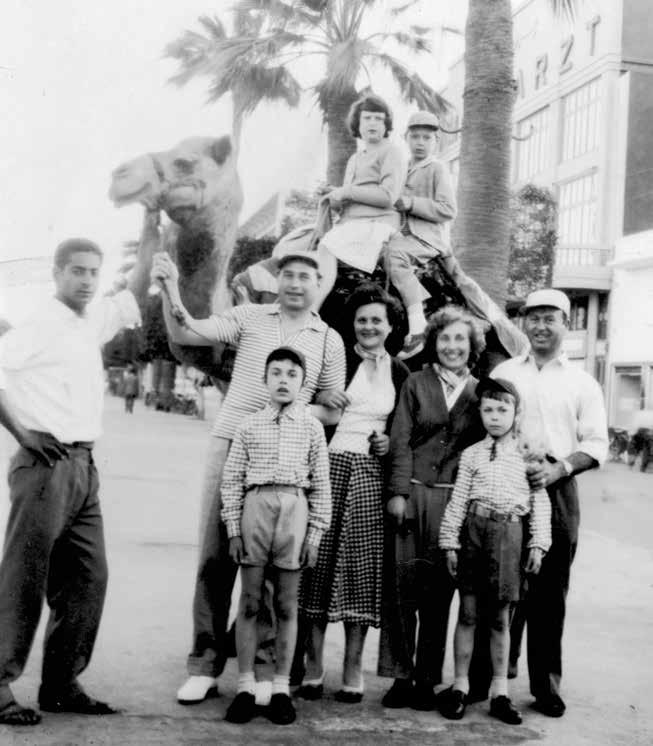

If Australians have learned one lesson from the Pacific War now moving to a successful conclusion, it is surely that we cannot continue to hold our island continent for ourselves and our descendants unless we greatly increase our numbers. (Arthur Calwell, Minister for Immigration, 1945)
WORLD WAR II was without doubt a defining event of the 20th century. It also profoundly affected Australia’s immigration policy, highlighting the necessity of population growth for the nation’s defence, security and economic development.
In July 1945 Prime Minister Ben Chifley established the Federal Department of Immigration and appointed the first Minister for Immigration, Arthur Calwell, who introduced a more coordinated approach to building Australia’s population through mass migration. In the lead-up to the 70th anniversary of planned post-war immigration, three new showcases in the museum’s Passengers exhibition recall pivotal moments in the first decade after the war, which would begin transforming this country from a ‘white Australia’ into a multicultural nation.
The Australian government launched its immigration program with the catchcry ‘populate or perish’, negotiating agreements to accept more than two million migrants and displaced people from war-torn Europe. Departure from Genoa explores the stories of three European women, including renowned radio broadcaster Lena Gustin (1914–2003), who migrated to Australia through the Italian port of Genoa after World War II.
Lena, an Italian schoolteacher, married journalist Dino Gustin in 1940 and they had three children. With wartime deprivation costing the life of their elder son, the Gustin
family decided to migrate to Australia, arriving in Sydney on Aurelia in May 1956. Lena would become the highly regarded voice of the Italian community in Sydney, but she was also one of the city’s first baristas. Her daughter Rosalba remembers how Lena’s longing for a good coffee led to her first job in Australia:
My mother saw a brand new espresso machine [in a coffee shop in the suburb of Bankstown]. She walked in, and as she did not speak one word of English, gestured that she would like an espresso. The owner of the shop had absolutely no idea how to operate the machine. And so Mum showed him. And not only did she get her good espresso, she was hired on the spot to make proper espresso coffee for his customers – and wash the dishes.
Lena also taught Italian twice a week at Ashfield Evening College and worked as a columnist for the Italian Catholic newspaper La Fiamma (The Flame). In 1957 she helped to establish foreignlanguage broadcasting on Australian commercial radio by presenting Ora Italiana (Italian Hour) on Sydney Catholic station 2SM. This was followed in 1959 by a daily program on 2CH. Lena’s popular programs, produced by Dino, were one of the few media outlets through which Italian news was regularly reported, alleviating the isolation experienced by many new immigrants before the introduction of ethnic community radio and SBS (the Special Broadcasting Service, which provides multilingual and multicultural radio and television broadcasts) in the 1970s.
Departure from Genoa includes a number of items relating to Lena’s broadcasting career, such as a world clock that she relied on to give her listeners the local and Italian times, and a tape recorder that Dino
Lena Gustin became the highly regarded voice of the Italian community in Sydney, and was also one of Sydney’s first baristas

01 Lena Gustin (centre, in white top) and Dino (in striped top) with their children Rosalba and Robert (seated on camel) in Port Said, Egypt, 1956. Reproduced courtesy Mamma Lena and Dino Gustin Foundation
02 Lena Gustin interviewing the Italian singer Peppino di Capri in Sydney, 1968. Reproduced courtesy Mamma Lena and Dino Gustin Foundation
03 Portable ‘on air’ sign commissioned by Dino Gustin, 1960s. ANMM Collection Gift from Mamma Lena and Dino Gustin Foundation
01
02 Cigarette tin containing Tony Ang’s Australian and US Army badges, 1940s. Lent by Ang family

used to record the Italian news directly from RAI Italia radio in Rome. He would start his day at 4 am to listen to the news and then laboriously transcribe it for Lena to read on air the same evening. Also on display is a portable ‘on air’ sign that Dino commissioned for use during Lena’s promotional photo shoots, as a visual reminder of her connection to radio.
Lena’s pioneering radio work, combined with her support of Italian welfare organisations, earned her the affectionate nickname ‘Mamma Lena’ – Mother of the Italians. July 2014 marks the centenary of her birth and a range of commemorative events has been planned by the Mamma Lena and Dino Gustin Foundation to acknowledge her tireless social and charitable work during a very significant phase in Australia’s post-war immigration history.
Chinese seamen
At the same time that the Australian government was promoting mass migration from Britain and Europe, it was engaged in a bitter struggle to deport several hundred Asian evacuees and seamen who had assisted the Allied effort during World War II. The Chinese seamen showcase examines the little-known story of the
2,000 Chinese seafarers who were stranded in Australia following the outbreak of war in the Pacific. They were given temporary refugee status under a special exemption to the Immigration Restriction Act 1901 (colloquially referred to as the White Australia policy), which aimed to prevent the entry of non-European immigrants by making them take a dictation test; those who did not pass – which was most of them – were denied entry.
During the war Chinese seamen worked as crew on coastal ships that carried supplies to the war zone and were also deployed on large construction projects around Australia. In 1942, 1,000 men were sent to work on the construction of Warragamba Dam west of Sydney. Another 1,000 went to Bulimba, Brisbane, in 1943 to build landing barges for the US Army invasion of the Philippines.
Tony Ang (1914–1964) landed at Perth in 1942 after his ship was torpedoed and, like many stranded seafarers, he enlisted in the Australian Military Forces (AMF), serving with the 7th Australian Employment Company (Chinese). After an honourable discharge from the AMF, Tony was among the seamen transferred to Bulimba.
While stationed in Bulimba, Tony met Marjorie Pettit, who lived near the army barracks on Apollo Road. The couple married in 1944. When the war ended, some 300 seamen, including Tony, sought to remain in Australia but Labor minister Calwell was determined to repatriate them. A legal battle erupted between this ‘recalcitrant minority’ and the government that challenged the basic tenets of the White Australia policy, and established that those who had been in the country for more than five years could no longer be subjected to dictation tests or declared prohibited immigrants. Calwell responded by introducing the Wartime Refugees Removal Act 1949 to deport them.
By this time Tony had lived in Australia for seven years and had three young sons. He left Australia in June 1949 and Marjorie and the children chose to go with him. The family’s departure for Hong Kong


on Changte was captured in all the newspapers, including The News, which featured a heartbreaking photograph under the headline ‘Another family deported’.
With Tony unable to find work, the family was forced to live in a crowded slum area in Kowloon and endure conditions that Marjorie described as ‘filthy and awful’. After five difficult weeks, with her sons ill, Marjorie had no choice but to return to Australia without Tony. Ahead of her arrival in August she wrote:
I will never forgive [the officials] for ruining the dearest and most precious thing in my life and Tony’s – our family. I will never forgive them every hour that our sons have lived in this filth and squalor, and every tear that we have shed.
In October Marjorie and her children moved to Hong Kong for a second time after Tony secured a job managing the canteen at Chatham English School on Victoria Peak. From Hong Kong Marjorie continued her appeals to the Department of Immigration about Tony’s case, which took a fortuitous turn when the Labor Government was defeated in the December 1949 federal election. The incoming Liberal Immigration Minister, Harold Holt, reversed Calwell’s deportation orders and granted residency to the seamen as a wartime legacy.
In June 1950 Marjorie finally received a letter, displayed in Chinese seamen, which gave approval for her husband to enter Australia. In September the family returned to Sydney, where Tony and Marjorie had three more sons. Tony became a naturalised citizen in 1961.
For Tony and Marjorie’s son Raymond, the family’s case represents ‘a turning point in history. From what we’ve heard they were in parliament talking about the poor Ang family, [saying] this is a disgrace’. The story of Tony Ang and the Chinese seamen reveals emerging challenges to the White Australia policy in the post-war period, which would lead to its gradual dismantling during the 1960s and 1970s.
02 Cherry and Gordon Parker. Reproduced courtesy Cherry Parker
03 Cherry and Gordon Parker (centre) and their two daughters depart Japan
Another step towards ending the White Australia policy came in 1952, when Immigration Minister Harold Holt lifted the ban on entry for Japanese wives of Australian men who had served with the British Commonwealth Occupation Force after the surrender of Japan in 1945. Although intermarriage was
strictly prohibited, many men, including Gordon Parker, fell in love and lobbied the Australian government for change. War and love tells the story of Gordon’s wife, Nobuko (Cherry) Parker (born 1929), who was the first Japanese war bride to arrive in Australia, paving the way for more than 600 other young women to be reunited with their husbands. These women were the first group of non-European immigrants officially permitted under the White Australia policy.
Cherry’s family home in Hiroshima had been destroyed by the atomic bomb in August 1945. In 1946, with food still desperately scarce, she took a job as a housemaid at the Australian army camp in nearby Kure. It was here that she met Gordon, a medical orderly from Victoria. Cherry and Gordon’s daughter Jenny describes the meeting:
The first day Mum started on the camp, she was in this room tidying it up, and Dad walked in. So it was the first ‘white person’, as Mum called him, and Mum was the first Japanese person Dad had virtually seen too. Dad was fairly tall, so Mum was absolutely petrified ’cause this big white man has walked in, and she’s cowering in the corner!
Cherry and Gordon married in 1948 and had two daughters. When Gordon was forced to return to Australia after his army discharge, many of Cherry’s friends believed he would not come back for her. But he did. With the influential support of his mother Mabel, a respected social worker, and father Harry, a former mayor, Gordon campaigned for four years until the Australian government gave permission for his family to migrate to Australia.
The Parker family departed Yokohama on Taiping in June 1952. Cherry carried a few mementos of Japan, including her daughter Margaret’s kimono and traditional kokeshi dolls, which are displayed in War and love. The family disembarked in Sydney in July and flew to Melbourne, where their arrival attracted much media attention.
Cherry and Gordon settled in Ringwood and were married for 62 years, raising eight children together. Their story provides a wonderful reflection of the power of love to overcome immigration policy, and with other new stories presented in Passengers, evokes the beginnings of multicultural Australia. As their daughter Jenny says:
Now you look around, we’ve become such a multicultural country. But you sort of think, had Dad not fought as hard as he did, and just given it up as too hard, what could’ve changed? It’s quite amazing …

When Gordon was forced to return to Australia after his army discharge, many of Cherry’s friends believed he would not come back for her


This year, the construction of our new Warships Pavilion will mark the first stage in an ambitious redevelopment of the museum’s site and exhibitions. The pavilion will both improve access to our three ex-naval ships and provide exciting new interpretations of them. Assistant Director Michael Harvey explains what is involved in bringing the stories of these vessels to life.

I AM SITTING IN A GROUP of people that includes museum staff, a television and multimedia writer, two multimedia producers and an illustrator, watching and listening as they collectively create a ‘storyworld’. We’re in the Cold War navy, and the wrong set of circumstances could turn it into a shooting war, with nuclear weapons involved. This world has different systems, different rules, different fears and even a different language from those of today’s world. In it, Australia’s naval personnel operate destroyers, submarines and patrol boats – all dangerous environments, even without the shooting. They live and work as part of a ‘floating ecosystem’ – a machine with human parts as well as metal ones. The team is establishing the rules of that world, in order to better tell the stories of these sailors and to breathe new life into the museum’s iconic naval vessels, HMAS Vampire, HMAS Onslow and HMAS Advance
Oral histories form part of the research for the first major project of the museum’s new masterplan, the Warships Pavilion
As I watch, the team’s discussions are turned into graphic cartoons encapsulating, in one image after another, memorable incidents, human doubts and fears, big-picture geopolitics, and individual crew roles and tasks. These give form both to our developing ‘storyworld’, and to the myriad oral histories that the team is gathering as part of its research for the first major project of the museum’s new masterplan, the Warships Pavilion. These cartoons will serve as a common visual language to illustrate our story ideas as we move
01 Previous pages: The new pavilion will improve access to and interpretation of the warships, and also provide the museum with a striking rooftop function space. Image courtesy FJMT Architects
02 The exhibition development team (from left: Heidi Reiderer, Annalice Creighton, team leader Hamish Palmer, Peter Buckley and Nicole Cama) at a brainstorming session on Cockatoo Island. Photograph Penny Edwell/ANMM
03 Illustrations by artist Alan Chen.
04 From left: Hamish Palmer, Mel Flanagan, Alan Chen, Mike Jones, Nicole Cama and Ester Harding surrounded by their storyboards, notes and cartoons. Photograph Penny Edwell/ANMM
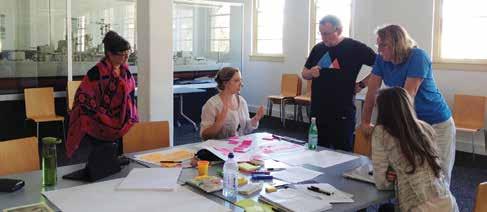


on to brief designers, writers and filmmakers to create the final pavilion experience over the next 18 months.
When we embarked on the task of developing a new building for accessing our warships, we knew that the approach would need to be very different from any we had undertaken before. It involved both a new exhibition and a whole new building – situated on the museum’s South Wharf, nestled between the imposing bulk of the destroyer Vampire and the sleek, dark form of the submarine Onslow. It would act as a vastly more convenient and comfortable entryway to the vessels than the current ramp-and-shipping-container arrangement and, by employing new display technologies and a new approach to storytelling, it will help visitors to experience the ships as never before.
Australia’s naval personnel live and work with each other as part of a ‘floating ecosystem’
The architectural firm FJMT has given us a building design that evokes the curving forms of both the ships and the sea. It is a building that sits confidently between the vessels but without overshadowing them – after all, they are the stars of the show. The building offers us both visitor spaces for interpreting the vessels, and open-air spaces that double as unique evening function venues. Now the museum’s exhibition development team must take the architecture a step further by creating a visitor experience that also complements
the vessels, adds to the experience of going aboard and makes that visit more special.
We know that the Royal Australian Navy’s story is a compelling one, which captures the imagination of many of our visitors.
Just last year more than 85,000 people visited the museum for International Fleet Review – and an estimated 1.7 million experienced Fleet Review activities across Sydney. We also know from our visitor interviews that they seek more guidance for navigating the ships, especially on Vampire. They would like more interactive experiences and more information than we currently provide, and would like to see more of the parts of the ships that are currently closed.
Though our naval vessels all span a period from the 1950s to the 1990s – an extremely helpful fact when trying to create a story that links all three – they also act as ‘standins’ for more than 100 years of Australian naval service. This year marks 100 years since the tragic loss of AE1, Australia’s first submarine, and next year sees the centenary of the dramatic exploits of AE2 off Gallipoli. As we walk around Onslow, we can remember the submarine service through all its iterations, from AE1 to the Collins Class and beyond. Similarly, Vampire and Advance both have their counterparts in other big-gun ships and patrol boats of the past – and in the navy of today.
So our pavilion must provide these things – a memorial to the lost and an acknowledgment of ongoing service; a dramatic ‘surround experience’ that takes visitors into our ‘storyworld’ and shows them the ships as they would have been at the height of their active service; and a resource where they can get more information about any of the aspects of the life of the ships and of those on board.
A week after my experience in the ‘storyworld’ workshop, I join a very different group of experts. This time, the focus is not on the mechanics of storytelling, but on the stories themselves. We have senior representatives from the Navy’s Heritage Centre, the Sea Power Centre (the navy’s own historical and strategic research centre), the Defence Science and Technology Organisation, and the Submarine Institute of Australia. Most of the people in the room have served on these or similar vessels and all have a deep knowledge of the technologies, the experiences, and the historical and strategic contexts that we are trying to explore. This group, with great enthusiasm, politely picks apart what we have done to date – honing when we have taken the story too far or exaggerated too much. And they encourage us to take some elements further. A lively debate ensues about whether we should give our younger visitors a ‘rat’s-eyeview’ tour of the ship – and concludes with an uproarious affirmative.
It’s at once sobering and uplifting –we have such a long way to go to realise this project, and we must push the boundaries of what such an experience can do for our visitors. Our own museum community – which includes a number of ex-navy personnel, the broader navy ‘family’ and an increasingly varied range of skilled practitioners – is making up a new ‘ecosystem’; one that challenges us and reassures us in equal measure. Full steam ahead.
The Warships Pavilion will begin construction this year and is expected to open to the public in 2015.
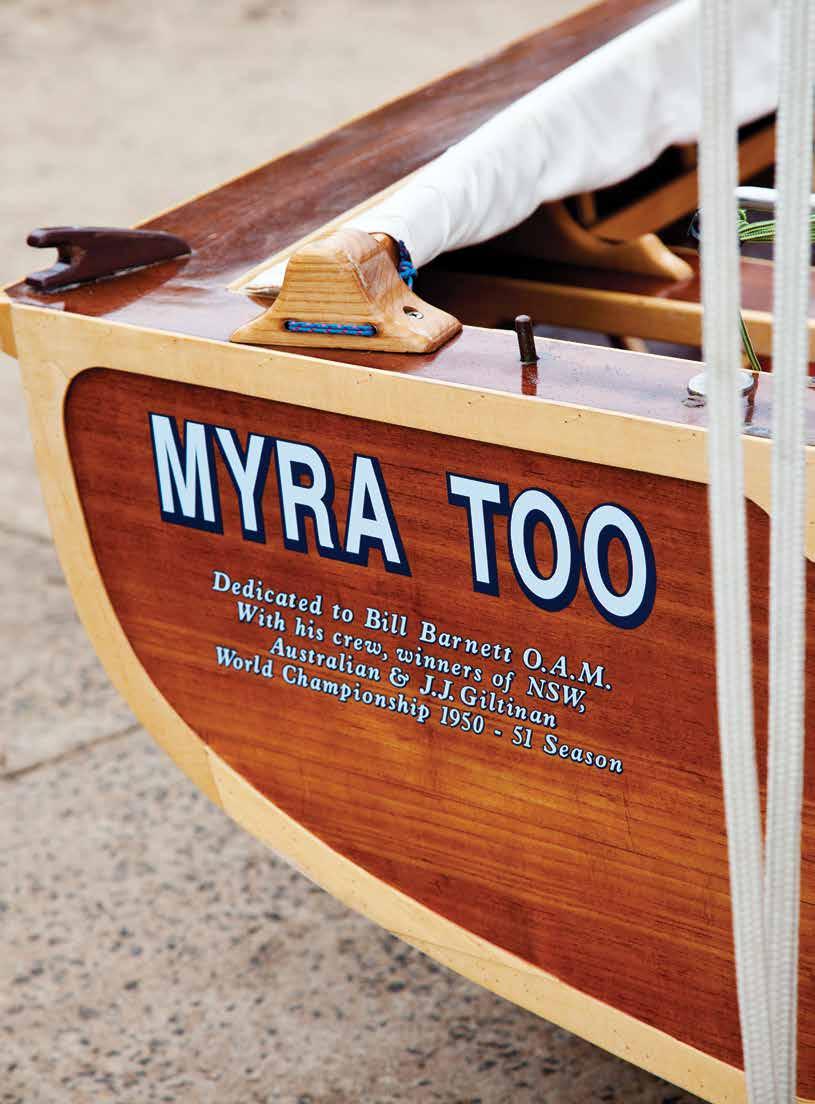 Photograph Zoe McMahon/ANMM
Photograph Zoe McMahon/ANMM
Several generations came together to see the fabulous replica and relive the memories of the classic days of skiff sailing
A project to build a replica skiff has brought people together in surprising ways, writes curator David Payne. It evoked memories and a huge sense of pride for two families. It gave its builders the challenge of re-creating it from scraps of 60-yearold memories and a few images. And it became a focal point for its many internet followers, and an excuse for gatherings of sailing enthusiasts.
WHEN THE REPLICA 18-foot skiff Myra Too was officially launched on 3 March 2014, its details – beautiful lines, varnished hull and the contrast of aged red cedar against silver ash – all told of the skill that had gone into the project. This was clearly an outstanding piece of boatbuilding.
The idea to build a replica of the 1951 champion 18-footer originated with the Australian Open Skiff Trust, which has been supporting a fleet of replica 18-foot skiffs sailing out of the Sydney Flying Squadron since 2006. Led by John Winning, it has organised the construction of replicas of significant skiffs from earlier eras, dedicating them to their original and now legendary builders and skippers. In 2012 it set about re-creating Myra Too – a vessel with all the ingredients to qualify. Sailing for the Sydney Flying Squadron, Myra Too had dominated the 1950–51 season, winning numerous club events, the New South Wales state championship, the Australian national championship and finally the J J Giltinan Trophy for the world championship.
After Myra Too’s Giltinan success, renowned New Zealand boatbuilder and skiff sailor Jack Logan was quoted in an Auckland newspaper as saying:
Myra Too was in a class by herself. There were seven other boats in the contest with the same beam as Myra Too and they did not do any better…
(R Elliot, Galloping Ghosts, page 133)
Myra Too had been designed, built and skippered by one of Sydney’s best shipwrights, Bill Barnett. In building the 2014 replica, however, information on the skiff’s hull shape was missing – lost in 1971 when a fire destroyed Bill’s boatshed, and with it the half-model he had shaped to create the skiff’s design.
The original Myra Too had also disappeared. Bill secured a buyer for Myra Too during 1951, and raced the following year in a new skiff, Myra III Myra Too was sold several times, becoming Merle, then Minnawatta Too, before gradually disappearing from the historical record.
So, to build a faithful replica – where do you start?
An easy step for the trust was choosing a builder – Bill employed a small but skilled workforce and always had an apprentice. One of these was young skiff sailor Bob MacLeod, who later worked with Bill on two well-known 12-Metre class yachts,

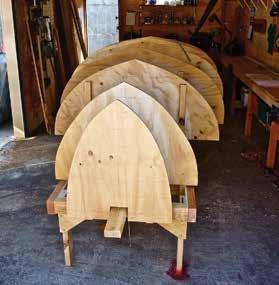

01 Myra Too’s bow. Photograph courtesy Bruce Kerridge
02 Setting up the mould stations for the replica Myra Too in Bob McLeod’s custom-built shed at Mona Vale, 2013. Photograph David Payne/ANMM
03 Designer David Payne checking bow entry, 2013. Photograph Penny Hyde/ANMM
Dame Pattie and Gretel II – international state-of-the-art yachts and the high points of Bill’s boatbuilding career. Although now in his 60s, Bob is still building or repairing craft. In 2008 he was a key member of the team that restored the 18-foot skiff Taipan, built in 1959 and now on display in the museum’s Wharf 7 Maritime Heritage Centre. Bob was humbled to be asked by the trust to build the replica Myra Too and give something back to his mentor and former boss.
To draw up designs for the replica Myra Too, the trust very kindly asked me to research what I could and come up with a set of lines for Bob to work from. This was also a chance for me to pay respect to Bill on behalf of my late uncle Alan Payne, who had designed Gretel II – which posed quite a challenge for Bill to build, as it used some unusual details in the construction. I have been documenting historic craft for the museum for nearly 20 years, and knew that this project would require gathering as much primary evidence as possible on Myra Too and Bill’s skiffs. Using weekend time I began preparing a drawing and then revising it, but we also had one extra source of input – the recollections of 99-year-old Bill.
We knew only that Myra Too was 18 feet (6 metres) long with a 6-foot (2-metre) beam, and since the skiff was never drawn, but was shaped from a half model, I thought the best approach to prompt Bill’s recollections would be to produce a half model from my draft plan, and discuss that with him. There were a few images that gave strong clues on the hull shape – many taken from Bill’s albums that his wife, Glory, had put together – but the best starting points were two grainy images of the Myra III half model that were published in Seacraft magazine in 1952 (Myra III was known to be similar to Myra Too). From these I formed the outline and significant details about the stern and bow shape before developing the rest of the lines.
Bob then made a half model, and I spent an hour with Bill sharing a cup of tea and chocolate biscuits while he went over the model, looking at it from different angles, feeling it with his hands and thinking back to some of the typical dimensions they may have used in 1951. It was invaluable input, and indicated that what I had drawn was correct in concept but required some fine-tuning in the detail. A key bit of reassurance was his comment that he made sure the top plank would fit comfortably in a full length running from the transom to the stem. It did not run off at the sheer a foot (30 centimetres) or so from the stem, as was typical on other 18s. This meant my interpretation of the full rounded bow was correct, and while the many points of detail meant rubbing out much of what I had drawn to revise the lines plan, it would then be a much closer representation of what Bill had done, rather than simply my estimate of the shape. This is a key point in getting a replica right – trying to do what the individual designer did, rather than compiling an aggregation of features that might be typical of the type.
Myra Too’s impressive 1951 race record put high expectations on the replica’s potential
The layout was also reviewed and confirmed, based around the typical 18-foot skiff’s mast location, one third aft. In the area of construction, Bob McLeod had the major input. The brief was to produce a light and strong hull, one that could be sailed for many seasons. In 1951 Myra Too was light but well built, and really only expected to be in top condition for one or two seasons. Bob’s concept was to build a hull with planking, frames and stringers – items used on the seam batten carvel
hull in 1951 – but to make the entire panel much stronger. This was to be done by cold-moulding the hull planking in three glued layers bonded to the frames, and then running the stringers inboard of the frames – a reverse of the original arrangement, but ensuring a much tighter and stronger panel, albeit a little heaver. Bill’s comment was positive – the design was much stronger, and took advantage of methods he did not have available at the time. Later on in his career Bill became one of the pioneers of cold-moulding, and Bob was working with him at the time, so the experience rubbed off.
For longevity, Bob and I tried to make the structure stronger in strategic areas and the final adjustments to fitting locations were informed by lessons learnt on other replicas.
Some of Myra Too’s materials are noteworthy. The project was offered red cedar stock for the planking, milled from a 450-year-old tree that had been felled many years ago and saved for a worthy project. Cedar planks for the thwarts were recycled from an old building and carried marks of their earlier usage (a nice historical feature); rare klinki ply from under Bill’s house was used as the middle diagonal layer of the triple cold-moulded hull; and other timbers from Bill’s stockpile were used elsewhere in the structure.
Myra Too’s big rig in 1951 had been revolutionary – a bendy Marconi mast with a taller aspect ratio – but one of the Australian Open Skiff Trust’s objectives was to create close racing and avoid freak designs with special advantages, so the replica’s gaff-rig plans were based on successful rigs in previous replica craft.
Then, in a timely find in late 2012, the museum’s digital curator Penny Edwell came across a set of previously unidentified photos of Myra Too and her crew during the 1951 season (see story on page 78). These photographs, from the museum’s

William Hall collection, pinpointed finer details of the champion 18-footer’s design that could be included in the construction process and even helped us to reshape the hull lines slightly.
Work started in late 2012 in a specially constructed shed, and Bob was helped by several generous volunteers. Between the beginning of construction and the vessel’s test sail in January 2014, many things happened along the way.
Firstly, Myra Too became a bit of star. Bob had to make a visitors’ book to manage the vessel’s growing popularity. Bill Barnett was brought down to check on progress, sailing writers such as the revered Bob Ross came by, and photos were taken almost daily to record the build. Behind the scenes, the Australian Open Skiff Trust sought support. The resins were supplied by Norglass as sponsorship and other materials and parts came as goods in kind.
Midway through, a fundraiser and celebration of Bill Barnett’s career was held at the Sydney Amateur Sailing Club – a huge party with hundreds of guests, providing a platform for the trust to show what it can do to the wider sailing audience.
At the museum, both the historic photos and our photos of the build were uploaded to the web along with regular blogs reporting on progress. This web presence built support and awareness of the project, and also brought in valuable information as members of the sailing community got in touch with extra historical details about our photos.
Then, in March 2013, 81-year-old Brian Stewart was surfing the web when he came across this photographic collection, in which he appeared, sailing as Myra Too’s 19-yearold bailer boy. He was on the phone to Penny in no time, his excitement
almost palpable. Aside from Bill Barnett, Brian was the only other 1951 crew member still alive and he remained in touch with the museum throughout the year, awaiting news on Myra Too’s launch.
Final fit-out details were completed by members of the trust, while spars and sails were put together by Goldspar and Herrick Sails respectively. On 4 January this year, Myra Too went sailing: sitting to its lines on a nice buoyant hull, balanced on the helm, accelerating well and barely taking any water – just how Bill Barnett said it should go.
Watching the replica skiffs sail the next weekend was a great experience. Gybing these craft downwind with the kite up is an art. Headsail down, main boom across, new brace set up, clew through across the pole, brace back on the new side, sheet on, headsail up – and then Myra Too was scooting away again.
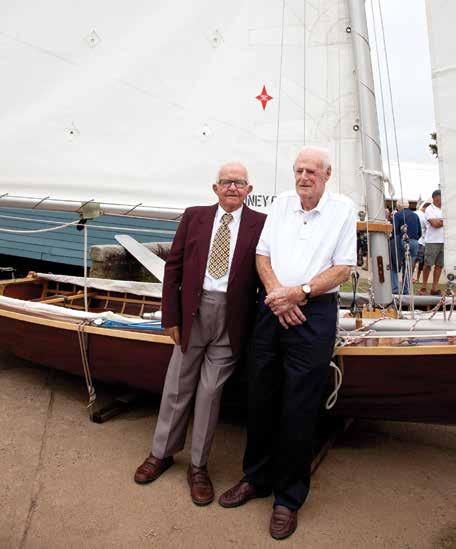
That’s where the fun is, but sailing a replica has its challenges, too, and in this case Myra Too’s impressive 1951 race record put high expectations on the replica’s potential. A fortnight later it was thrust into the Australian Historic Skiff Championships. In gusty and windy conditions, Myra Too ended up mid-fleet, knocking on the door of the consistent top four skiffs. It showed great pace downwind, but upwind there is work to be done on the set-up. This comes with time on the water – Bill and his crew had some years of experience in that type of 18, and replicating this will take a while.
Then came the christening in March 2014. The day really belonged to Bill and Brian, who had plenty of catching up to do after many years apart. They were joined by their wives, Glory Barnett and Betty Stewart, Bill and Glory’s daughters Cynthia and Margie Barnett, and other family
members – several generations coming together to see the fabulous replica and relive the memories of those classic days of skiff sailing.
Sharing the celebrations were other ex-skiff sailors from Australia and New Zealand, America’s Cup yachtsmen, world champions and sailing supporters. This extraordinary gathering of the past was choreographed by the irrepressible John ‘Steamer’ Stanley, whose masterstroke was to have the christening of Myra Too double as a history lesson for the latest skiff sailors, as it took place in the very same spot where they were rigging their boats for Heat 2 of the J J Giltinan trophy that Myra Too had won in 1951. The christening drew the curtain on a project where an exceptional mix of past and present all came together around one boat – the replica 18-foot skiff Myra Too.
01 The Myra Too replica under sail. Photograph courtesy Bruce Kerridge
02 Brian Stewart and Bill Barnett in front of the replica at the Sydney Flying Squadron. Photograph Zoe McMahon/ANMM
03 Pocket from Brian Stewart’s 1951 team blazer. Lent by Brian Stewart

81-year-old Brian Stewart was surfing the web when he came across our photographic collection, in which he appeared, sailing as Myra Too’s 19-year-old bailer boy

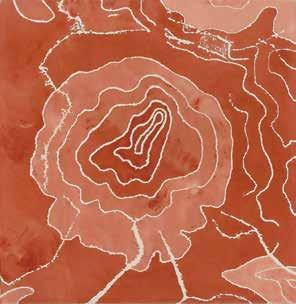
01 Michael Cook, Undiscovered #4, 2010. In a role reversal, the assertive uniformed figure posing on the shore is not James Cook or another European, but an Aboriginal man. Michael Cook’s works ask what position Indigenous people would have been in if the land had not been considered as ‘undiscovered.’ Courtesy Andrew Baker Art Dealer & Dianne Tanzer Gallery + Projects 02 Judy Watson, tibberwuccum, 2005. One of a series of works that engage with the Glass House Mountains in Queensland, and in which ideas of European cartography combine with Aboriginal ochre colours. Courtesy Milani Gallery, Brisbane
James Cook looms large in Australian history as the first European to sight the mainland on Australia’s east coast. His journals record many encounters with the Indigenous inhabitants, and a new exhibition at the museum, East Coast Encounter, now reimagines these first contacts from dual perspectives.
I N 1770, DURING THE FIRST of three voyages of discovery into the Pacific Ocean, Lieutenant James Cook charted hundreds of kilometres of Australia’s east coast. Cook’s orders from his Admiralty masters were ‘with the consent of the natives to take possession of convenient situations in the country’; yet the British managed only the most limited exchanges with the native peoples, and their consent was not asked due to the British crew’s inability to understand or communicate with them. In his log Cook often noted seeing signs of habitation – including on the very day that he planted the British flag on Possession Island and claimed the east coast in the name of the British Crown on the basis that the country was uninhabited, or terra nullius
Cook’s ‘discovery’ set in train an audacious social experiment – the establishment of a British penal colony on the other side of the world, which against all odds would thrive to become Australia. While the prevailing European view of Cook is of a great explorer whose expedition led to the founding of our nation, to many
Indigenous Australians he is a symbol of their own dispossession. The contacts that he and his crew made with the coastal Indigenous peoples are remembered in their oral histories and, in East Coast Encounter, Indigenous and non-Indigenous artists respond to interactions between the original inhabitants and the visitors through artworks, video, essays, song and poetry.
Among these works, Badtjala/Gubbi Gubbi linguist Gemma Cronin has translated a song that refers to Cook’s passing of Indian Head (named after the ‘Indians’ he observed there) on K’gari or Fraser Island – a headland that is also depicted in Peter Hudson’s watercolours. Reg Mombassa’s Jim Cook Mugshot portrays Cook in the style of a ‘Wanted’ poster that states ‘Executed for armed robbery by the people of the South Pacific – Feb 14th 1779’. Neil Murray’s poem ‘Sign of habitation’ imagines the reactions of Aboriginal people to Cook’s arrival on their shores, and asks ‘How do we make friends with those who take without asking?’, while Euan Macleod’s multi-panelled painting Possession Island came out of a trip to that island, also known as Bedanug, in 2012.
Exhibition co-curators Lisa Chandler and John Waldron write: Through its collection of art, writing, historical material, film and song, East Coast Encounter presents an imaginative exploration of this shared story and allows differing worldviews to sit alongside each other. By enabling histories to be expressed in multiple ways and from varied perspectives the exhibition seeks to reimagine this significant encounter in order to deepen the nation’s cultural dialogue and promote reconciliatory understanding between Indigenous and non-Indigenous Australians.
East Coast Encounter is on show from 9 May to 24 August.
This project has been developed by the University of the Sunshine Coast and assisted by the Queensland Government through Arts Queensland and the Australian Government through the Australia Council for the Arts, its arts funding and advisory body. eastcoastencounter.com.au
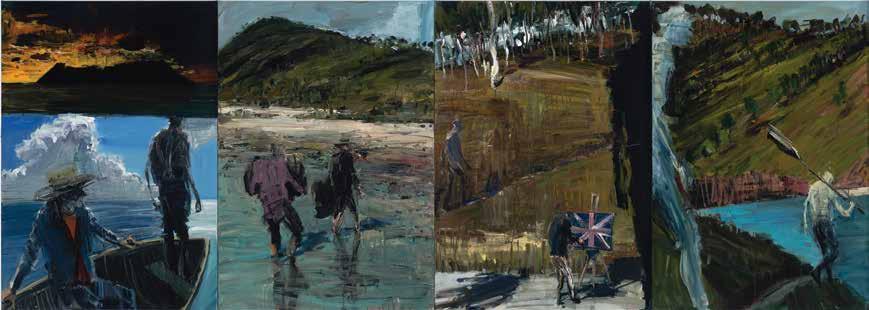



The contacts that Cook and his crew made with the coastal Indigenous peoples are remembered in their oral histories
01 Euan Macleod, Possession Island, 2013. The artist ‘was particularly taken with how the “white devils” must have seemed to the local inhabitants’, and his multipanelled work represents a story that needs to be understood from different perspectives.
02 Gail Mabo, Constellation, 2014. This work depicts glowing orange forms –ancestral beings and a tall ship representing the European incursion into this world – against a vast night sky full of stars that guided both the Indigenous peoples and the Europeans. Courtesy Monsoon Press for Umbrella Studio
03 Euan Macleod, Suitcases, 2013. The painting represents the idea of Cook and his crew as well as current-day immigrants bringing both literal and metaphorical baggage to a new land.

T HE AUSTRALIAN NATIONAL Maritime Museum has transformed one of its temporary exhibition spaces into a stateof-the-art venue – the Lighthouse Gallery. It stands on the waterfront alongside our Cape Bowling Green Lighthouse.
The spacious gallery is equally suited to temporary exhibitions (it recently hosted the publicly acclaimed exhibition Vikings –Beyond the Legend ) and events. It has been designed with the flexibility to cater for diverse occasions, from conferences or cocktail parties to wedding receptions. In-house audiovisual technology can be adapted to suit a variety of event styles, as can the exceptional, award-winning cuisine. Themed or tailor-made packages can offer attendees exclusive benefits, such as after-hours access to the museum’s exhibitions and attractions.
The museum’s team has extensive experience within the events industry, and created the Lighthouse Gallery to meet a clear need within the Sydney event market for a venue that would comfortably accommodate a reception for 250 people or a cocktail event for 400 guests.
The Lighthouse Gallery is just one of eight venues at the Australian National Maritime Museum, each with its own unique look and feel (see below). Members and volunteers of the museum receive a 10 per cent discount off venue hire when booking events at the museum.*
HMB Endeavour
The acclaimed Australian-built replica of Captain Cook’s famous ship of discovery offers guests a historical experience, with the option to enjoy cocktails on the quarterdeck or dinner in the Great Cabin. Endeavour also makes a striking backdrop for wedding photos.
HMAS Vampire
For a once-in-a-lifetime experience, host an exclusive dinner for 30 people or cocktails for 200 aboard our ex-naval destroyer, which provides a unique vantage point, particularly from its helipad.**
The Terrace Room
The museum’s premier conference and dinner venue provides amazing views
by both day and night, plus a spacious balcony. Many of the museum’s Members have enjoyed this space for wedding ceremonies or receptions.
Yots Cafe
The stylish Yots Cafe offers harbourside alfresco dining during the day, and stunning views of the city for evening events.
Ben Lexcen Terrace
This spacious rooftop terrace offers spectacular views of the skyline and harbour basin and is ideal for wedding ceremonies, cocktail functions and dinner receptions.
Tasman Light Gallery, The Theatre
Rounding out the venue portfolio are the Tasman Light Gallery, perfect for an intimate dinner, and The Theatre, ideal for corporate presentations.
For more information, see anmm.gov.au
For bookings, contact venues@anmm.gov.au or phone + 61 (02) 9298 3649
* No discount is available on venue hire for vessels. The 10 per cent discount applies to room hire only.
** Vampire is available for hire only in the evenings.


Until 20 July
Whales, dolphins, porpoises, the beluga and narwhal are known as cetaceans, an order of marine mammals comprising some 87 species. Of all the mammals, cetaceans have undergone the most spectacular evolution, from a small hoofed land animal to streamlined creatures of astounding variety that spend their entire lives in water.
Our exhibition Amazing Whales – Evolution and Survival traces their development, beginning 55 million years ago, when the archeocetes – early cetaceans – began to emerge. Their heads, jaws, spines, tails and limbs all underwent profound changes as they gradually transformed from a terrestrial lifestyle to a fully aquatic one.
Today’s cetaceans are the descendants of these archeocetes, which diversified spectacularly, spreading throughout the planet’s oceans, from the poles to the tropics, and from the surface down to great depths; some even colonised fresh water.
Amazing Whales combines striking life-sized models with anatomical specimens to show the diversity and adaptations of the cetaceans. Videos show behaviours such as play, courtship, mating and hunting. Human relationships with cetaceans are also explored, from ancient myths and legends to whale hunting, environmental threats and the rise of conservation groups determined to protect these magnificent mammals.
Entry with Whale Season ticket
(also includes entry to Beautiful Whale, and other museum galleries and vessels). Members free.
anmm.gov.au/whaleseason
#whaleseason
Presented in association with the Muséum National d’Histoire Naturelle, Paris.
01 The exhibition features life-sized models of the heads of various species: that of a northern right whale clearly shows its baleen plates. Photograph A Frolows/ANMM
02 Undiscovered 4, 2010 by Michael Cook
03 Group of migrants on MV Toscana at Trieste, Italy, 1954. ANMM Collection Gift from Barbara Alysen. Reproduced courtesy International Organisation for Migration 04 Humpback Whale Calf I (detail), courtesy Bryant Austin/studio:cosmos



East Coast Encounter –re-imagining the 1770 encounter
9 May–24 August
East Coast Encounter is a multi-arts initiative involving Australian Indigenous and non-Indigenous artists, writers and songwriters to re-imagine the encounter by Lieutenant James Cook and his crew with Aboriginal people in 1770.
This project has received administrative and financial support from Sunshine Coast Council, Museum and Gallery Services Queensland, The University of the Sunshine Coast, Arts Queensland and the Australia Council. eastcoastencounter.com.au
Coming to Australia –Photographs from the IRO and ICEM
11 June–2 November
To mark Refugee Week, a small selection of photographs highlights the work of the International Refugee Organisation (IRO) and Intergovernmental Committee for European Migration (ICEM) in the 1950s. The photographs capture in vivid detail the anticipation and anxiety of European migrants coming to Australia in the turbulent years after World War II.
Beautiful Whale – Life-size photography by Bryant Austin
Until 1 February 2015
Come eye-to-eye with whales at sea in this remarkable photographic exhibition. American Bryant Austin is the only photographer in the world producing life-size images of whales, including dwarf minke whales from the Great Barrier Reef, sperm whales from the eastern Caribbean and humpback whales from the South Pacific. Austin takes up to three months to become accepted into a group of whales then, using just a snorkel, he waits for a whale to come less than two metres from his camera lens. At this intimate distance, all of its true colours, subtle tones and fine details can be captured.
Funded by the USA Bicentennial Gift
16 August 2014–22 February 2015
If you’ve ever wanted to pilot an airship, ride on a hovercraft, or control traffic in a city, now is your big chance! Going Places is an interactive science exhibition that explores the technology humans have developed for travel, and the way that travel has shaped the social fabric of our time. Visitors will also see pioneering technology to make the farthest reaches of our planet accessible. Going Places will be a wild ride!
Produced by Scitech, Perth, Western Australia
ANMM travelling exhibition
Waves & Water – Australian beach photographs
McClelland Gallery + Sculpture Park, Victoria
11 May–3 August
Iconic photographs from the Australian National Maritime Museum’s collection capture Australian beach culture from the 1930s to 2000: sunbathers, swimmers, surfers, surf lifesavers and ocean pools, by Max Dupain, Jeff Carter, Ray Leighton, Ian Lever, Roger Scott, Anne Zahalka and Narelle Autio.
Coming soon
War at sea – The Navy in WWI
12 September 2014–3 May 2015
The Royal Australian Navy (RAN) played a significant role in World War I, and served in all theatres of war, from the Pacific and Indian oceans to the Mediterranean and North seas. Its story will be told through the experiences of sailors – the drudgery of patrolling and blockading, the intense actions of battle, and the incredible voyage of submarine AE2 through the Dardanelles Straits – and via first-hand accounts from diaries and journals, objects, and film and interactives.
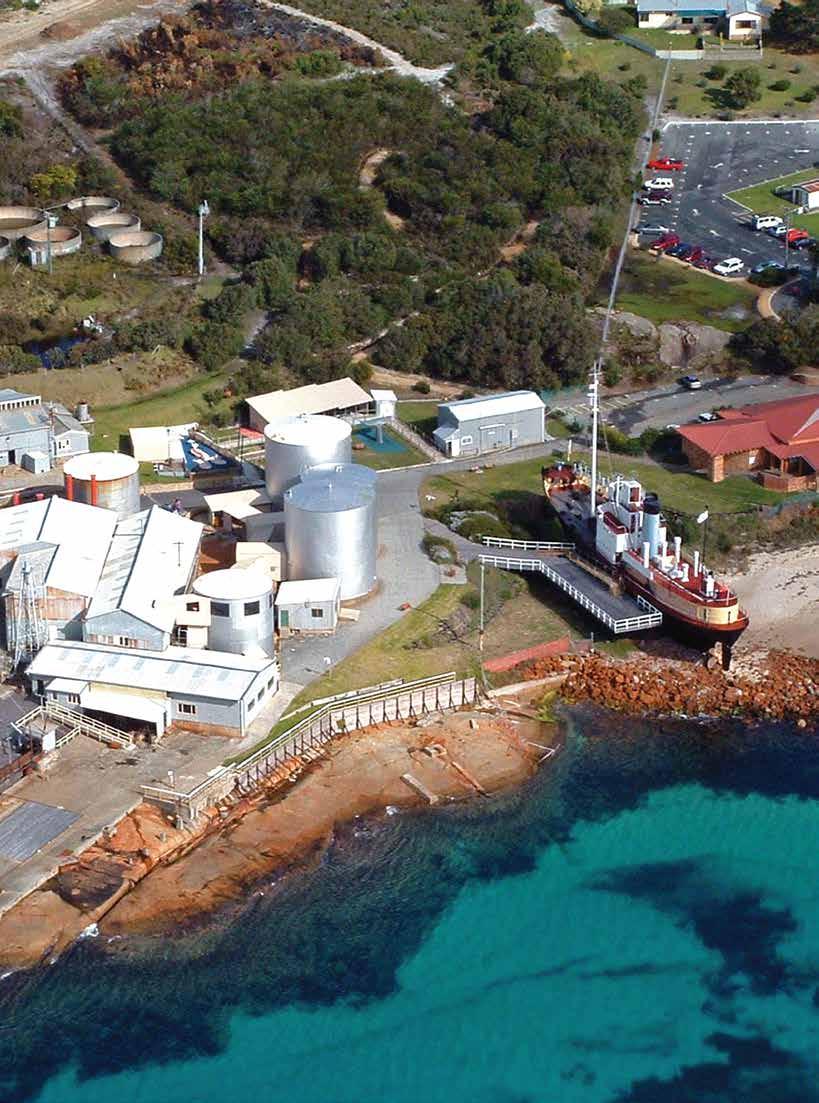
MARITIME
The site of Australia’s last whaling station is now a museum to the whaling industry, with attractions such as Australia’s only accessible whale-chasing ship, theatres built out of whale-oil storage tanks and a collection of photographs capturing the last eight years of the station’s life – including its turbulent end. Discovery Bay’s retail manager Alice Ackley relates the station’s history.
OVERLOOKING PICTURESQUE Frenchman
Bay south of Albany, Western Australia, on the edge of the Torndirrup Peninsula and National Park, stands the site of the last whaling station to close in Australia. The former Cheynes Beach Whaling Company station has now been transformed into Discovery Bay’s Historic Whaling Station, preserving and sharing the unique whaling history of Albany and Australia. Travelling along this beautiful coastline, it can be hard to imagine that it was home to such a rich and dramatic whaling past – one that could easily have been forgotten and lost. When whaling operations ceased in 1978, the company quite simply put down tools, locked the gates and left. It was through the generosity of one of the final shareholders, Colin Green,
that the site was gifted to the not-forprofit Jaycees Community Foundation, so that the station and its history would be preserved for future generations. Without this foresight, the buildings and supporting machinery might have been removed and sold, or allowed to fall into complete disrepair. In either case, the site would have been lost to modern society and the story of whaling could not be told as authentically as it is today.
Discovery Bay’s Historic Whaling Station, formerly known as Whale World, opened officially on 26 December 1980 and has operated almost daily since, closing only on Christmas Day each year. The site is on the state heritage list as the most intact whaling station in Australia, and is considered one of the best-preserved
whaling stations in the world. Only two other original whaling stations have been preserved , in Norway and South Georgia - neither of them accessible year round due to the local climate. Such an international point of difference ensures that the contribution of Discovery Bay’s Historic Whaling Station to heritage tourism in Australia is both unique and meaningful. Visitors to the Historic Whaling Station interact with the cultural and industrial history of the site through a careful mix of interpretation, including guided tours, well-placed interpretive signage and multimedia displays. Visitors joining a tour are taken to the actual processing factory, where they can stand on the restored flensing deck and see first-hand the massive winches used only 36 years ago to drag the
Visitors can stand on the restored flensing deck and see first-hand the massive winches used to drag the whales up from the water for processing
whales up from the water for processing. Films, including a 3D movie on whales, are projected in theatres custom built inside the large tanks once used to store whale oil. There are also massive whale skeletons on display in the original storage sheds, and one of the original whale chasers to explore. It is through such careful use of the buildings and surrounds that the Historic Whaling Station delivers its whaling heritage messages.
Albany’s rich whaling history spanned many generations. Whaling was one of the first industries in the region, beginning even before the Albany settlement was truly established. The economic benefit provided by the whaling industry helped to develop the town by providing employment and a viable export product. Old-style whaling reached a peak around 1845, when there were approximately 300 whale ships (mostly American) and numerous shore stations operating along the south coast of Australia. The numbers declined rapidly after 1859, when petroleum oil was discovered, with only a handful of whaling ships remaining after the turn of the 20th century.
In 1912 a Norwegian company obtained a whaling licence from the Western Australian government and operated from both Frenchman Bay and Point Cloates off the west coast. It did quite well for a few years, using modern steam chasers fitted with harpoon guns. However, after a poor season in 1916 and pressures both in Australia and Norway due to World War I, it closed down and went home. Not until the establishment of the Cheynes
Beach Whaling Company (CBWC) in 1952 did modern-day commercial whaling truly begin in Albany. Over the 26 years of the station’s operation, more than 14,000 sperm and humpback whales were caught and processed for their valuable oil.
In the latter years the CBWC operated with three whale chasers in its fleet – the Cheynes II, Cheynes III and Cheynes IV. These ships would depart from the Albany town jetty before daybreak, passing by the CBWC site as they headed towards the continental shelf, 30 nautical miles south of Albany, in search of whales. After daybreak, the ships would be joined by a Cessna 337 spotter plane, and the task of locating and harpooning the whales would begin. Each evening, the whales caught would be towed back to Albany and tied to a buoy in front of the station. This was the end of the shift for the crew on board the three whale chasers, who would return on the ships to the town jetty. At 4 am the following day the station would kick into life, processing the whales caught the previous day. The men who worked on the flensing deck had the gruesome task of cutting up (flensing) each whale and feeding the chunks of whale blubber into large cookers to heat it and extract the valuable whale oil. This process was repeated daily during the whaling season, March to December, right up until the last whale was caught on 20 November 1978 and the gates to the station closed for the final time on 21 November 1978. The closure of the CBWC was deeply felt throughout the town. Whaling had provided Albany and its
01 Previous pages: Aerial shot of the Historic Whaling Station in the 1990s.
02 The Historic Whaling Station and Frenchman Bay in the 1990s.
03 Visitors exploring the processing factory, which houses the two large cookers used to heat whale blubber and extract the oil.
04 The 45-metre-long Cheynes IV is Australia’s only accessible whale chaser.
All photographs courtesy Discovery Bay’s Historic Whaling Station
residents with much-needed employment and economic benefit. However, the market for whale oil had decreased to a point that it was no longer viable for the CBWC to continue operating, especially in opposition to the increasing power of the anti-whaling movement, whose protests at the station had resulted in heated scenes and dramatic headlines in the second half of 1977.
It is the most intact whaling station in Australia, and is considered one of the best-preserved whaling stations in the world
After the station’s closure, the future of its three whale chasers was uncertain. Cheynes II and Cheynes III were sister ships built in Middlesbrough, England, in 1947 under the names Thorbryn and Thorgrim Their first owner had been Whale Products Pty Ltd in Tangalooma, Queensland, which renamed them Looma II and Looma III In 1963 the CBWC purchased both ships, renaming them Cheynes II and Cheynes III respectively. They both remained with the station right up to its closure in 1978. In 1979 Cheynes II was given to the Hobart Maritime Museum, before being sold in 1983 to Bob Barnett for an Antarctic expedition then, in 1984, to an entrepreneur who planned to convert it into a floating restaurant.

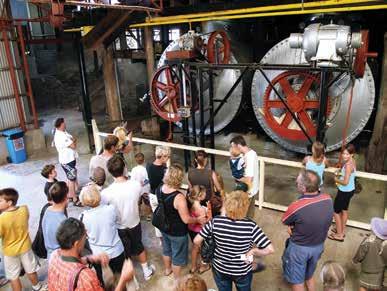

01 Air was pumped under a whale’s blubber to make it float, and a flag and radio beacon were attached so it could be located and towed back to the station at the end of the day.
02 Men at work on the flensing deck.
03 Flensing in progress, using the large and very sharp knives required for the task.



04 A harpooned whale was brought alongside the ship, tow chains attached and cuts made in the tail to indicate what number whale it was for that day.
05 Huge winches on board the whale chasers were used for moving and securing the whales in the water and alongside the chaser.
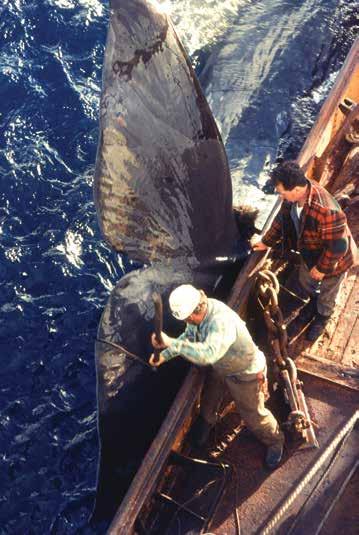

During a storm one night, however, the ship broke its moorings and drifted over to a sand bank on the other side of the harbour in front of Quaranup, the old quarantine station. It still lies there today, a derelict wreck.
The Cheynes III had a slightly different end – on 23 June 1982 it was scuttled in King George Sound, Albany, and is now one of the region’s premier dive wrecks. Fortunately, the Jaycees Community Foundation acquired the ship’s tripleexpansion steam engine before the scuttling, and this is now on display at the Historic Whaling Station in working order.
The men who worked on board the whale chasers had many risky and dramatic encounters with whales – and, in later years, with the vessels of anti-whaling protesters. One crewman in particular, Ches Stubbs, gave more than his time and hard work to the CBWC. On 22 October 1965, Ches readied and aimed the harpoon gun on Cheynes III for a third time, after two unsuccessful attempts to harpoon a whale. Upon firing, his left foot became entangled in the rope of the harpoon and was torn off. Amazingly, the spotter plane’s pilot, John Bell, was able to land his float plane in the rough seas and fly Ches back to Albany for medical help. Ches continued to work on board the ships after his accident and wrote a memoir of his experiences on board the whale chasers.
One of the main exhibits at the Historic Whaling Station is the Cheynes IV whale chaser, the largest of the three ships. Built in Norway in 1948, it was initially named W Fearnhead, and later operated for the Union Whaling Company in Durban, South Africa, under the name Wilfrid Fearnhead. In 1970 it was sold to the CBWC; renamed Cheynes IV, it stayed with the company until the station’s closure in 1978. In 1981 it was decided to move Cheynes IV from the Albany town jetty to the Historic Whaling Station as a permanent and accessible display. The massive task of safely moving the ship took a couple of years, finishing in 1984. It involved floating the whale chaser into the existing small sandy bay in front of the station, building a sea wall around the ship to create a dam in the bay, and then filling this dam with sea water until the ship could be floated into the right position. Another sea wall was then built along the western side of the whale chaser to create a smaller dam. This was filled with water, and sand taken from the land behind the station was pushed up and under the whale chaser until it was
sitting at the desired height. The remaining water was then pumped out and the area filled with more sand, permanently beaching the ship.
The relocation of Cheynes IV was not an easy feat, and nobody was keen to take the tender for the job. Its success is testimony to the ingenuity and determination of the late John Bell, the first full-time spotter pilot for the CBWC and the first manager of Whale World, as the Historic Whaling Station was then known. Work continued on Cheynes IV until it was ready to open to the public. The ship was available for viewing from 1985 to 1994, before closing until 1998 for major maintenance and the installation of an access deck. It is now Australia’s only whale chaser open to the public.
Another remarkable exhibit at the Historic Whaling Station is the collection of award-winning photographs by Ed Smidt, a photographer with the Albany Advertiser for 20 years (three of whose images are shown on page 5 of this issue). It records the last eight years of the CBWC operations, portraying life on board the whale chasers and at the whaling station itself. The sepia photographs are on permanent display in the Colin Green Heritage Gallery, a specially renovated shed which was the old CBWC store and radio workshop. Through funding support provided by the Maritime Museums of Australia Project Support Scheme, Discovery Bay, through the Jaycees Community Foundation, will publish a book this year. End of an Era will showcase Ed Smidt’s photographs, and capture the end of Australia’s whaling industry.
Today the Historic Whaling Station is still a key part of Albany’s cultural and maritime heritage. Through the tireless work of many individuals and the Jaycees Community Foundation, Discovery Bay’s Historic Whaling Station strives to preserve and interpret Australia’s last whaling station as a historic and cultural asset for this and future generations.
Discovery Bay’s Historic Whaling Station was highly commended in the 2014 Western Australian Heritage Awards, in the Outstanding Heritage Tourism Product category.
In October this year, Discovery Bay will open two exciting new attractions on the previously disused 20-hectare site behind the Historic Whaling Station. The new Botanic Garden showcases thousands of the South West region’s amazing wildflowers, and the Australian Wildlife exhibit has an array of native fauna. For further information please visit discoverybay.com.au.
When whaling operations ceased in 1978, the company quite simply put down tools, locked the gates and left
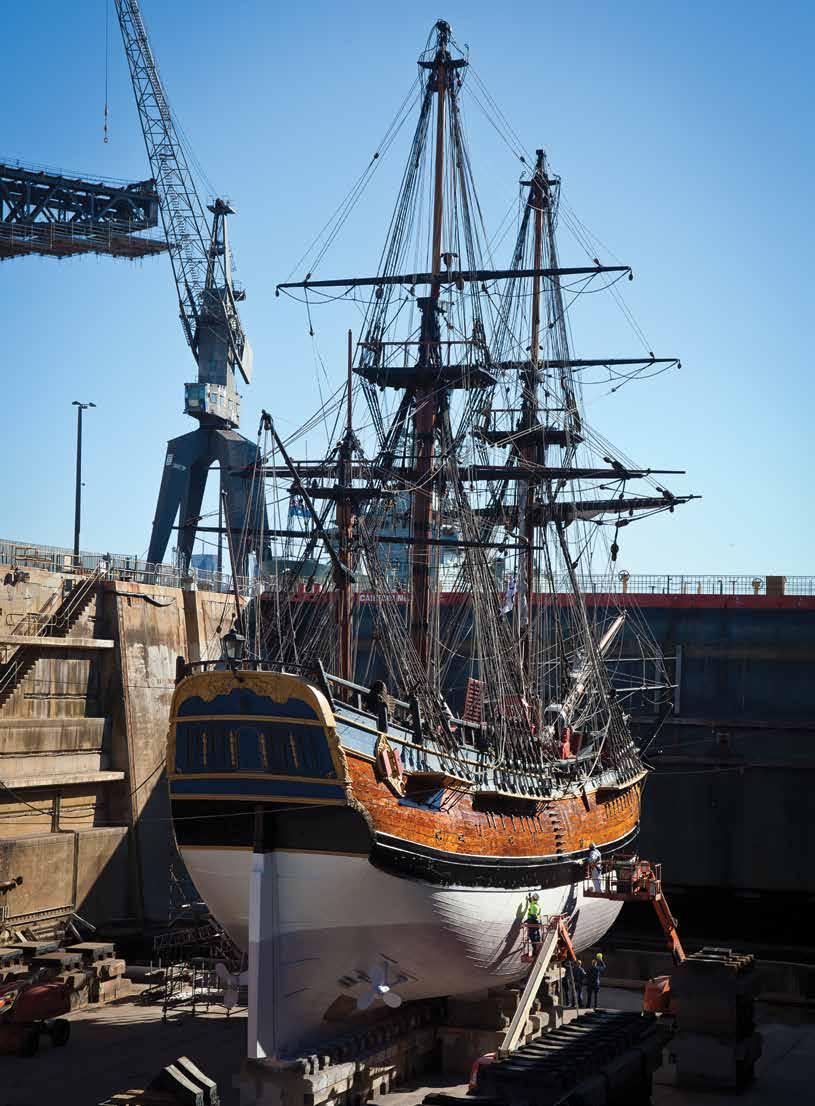

01 Endeavour in dry dock at the Captain Cook Graving Dock in Sydney, 2013, as part of her survey process. Photograph A Frolows/ANMM 02 Endeavour has twice circumnavigated the world, so must be able to withstand all weathers. She is seen here beam reaching in 50 knots of wind. Photographer unknown
LOOKING AFTER AUSTRALIA’S BEST-KNOWN SHIP
The museum’s replica of Captain James Cook’s Endeavour leads a double life as a museum exhibit and a seagoing ship that undertakes regular voyages and must be able to weather all conditions. Her captain, John Dikkenberg , describes what happens behind the scenes to keep this remarkable vessel shipshape.
THE REPLICA of Captain James Cook’s HM Bark Endeavour is recognised around the world as one of the great replica ships of the 20th century. For the museum, she is a drawcard for thousands of local, interstate and overseas visitors, and is valued as an exhibit, while also remaining a well-founded seagoing ship. Finding the balance between these roles is sometimes challenging but, in the main, the ship fulfils both roles extremely well.
Much must be done in the background to keep the ship ready to sail. Anyone familiar with merchant ships will be aware that these require a survey certificate under which they are permitted to operate. Endeavour ’s surveys are conducted by the Australian Maritime Safety Authority (AMSA). AMSA visits the ship every 12 months and every second visit includes a dry docking. We are due to dock down again about this time next year.
Getting ready for a survey review is quite a process, and preparations begin well before the actual day. AMSA requires that all safety-related equipment is checked and certified, which involves a large number of contractors and suppliers. For a month or two before the arrival of the surveyors we are certifying radios, navigation equipment, liferafts, seaboats, internal tanks, wiring and a multitude of other equipment. We are also ensuring that our safety management system, planned maintenance system and rigging maintenance regime are all up to date.
On the day of the actual survey, Endeavour must demonstrate the ability to deploy an anchor and to launch and operate the seaboat. The ship is then taken out on the harbour, where the surveyors ensure that all plant and machinery work and that the ship can manoeuvre within acceptable parameters.
01 Endeavour’s standing rigging is constantly overhauled and individual components replaced as needed, but in 2010 the entire standing rigging was replaced in readiness for a circumnavigation of Australia. Here, rope has been turned and seized (joined with close turns of small rope) for deadeyes in the ends of stays.
Photograph Anthony Longhurst/ANMM
02 At evening training sessions aboard Endeavour, voyage crew practise setting and taking in sail. ANMM photographer

Another aspect of the survey process is meeting the emerging requirements of the UN special body known as the International Marine Organisation (IMO). The IMO regulates the world’s shipping through a large number of conventions collectively known as the Safety of Life at Sea (SOLAS) Conventions. The SOLAS Conventions were first introduced after the sinking of RMS Titanic in 1912 and have been constantly updated and added to since. Recent SOLAS changes have included the requirements for seagoing ships to carry more sophisticated radio and satellite communications equipment, and the requirement for improved aids to navigation and improvements in ship design and construction. Many of these requirements are as applicable to replica vessels such as Endeavour as they are to cruise ships such as Queen Mary 2.
Endeavour is certified both as a passenger ship operating on smooth waters such as harbours and bays, and as a cargo ship able to operate anywhere in the world
The annual survey for Endeavour was recently completed and the ship is now cleared to operate for another 12 months. The ship actually carries two certificates: one as a passenger ship operating on partially smooth waters such as Sydney Harbour (known as Class 1D) and one as a cargo ship, able to operate anywhere in the world (known as Class 2A). The former speaks for itself and allows Endeavour to embark a large number of passengers for
When at sea, Endeavour carries 56 people – just over half the number that Captain Cook carried. It must have been cosy in 1770
operations on harbours and bays, but she generally operates under her 2A survey. As a Class 2A vessel, Endeavour carries a professional crew of 16, up to 36 voyage crew and four supernumeraries, making a total of 56. Interestingly, that is just over half the complement that Captain Cook carried. It must have been cosy in 1770.
While the ship is not voyaging, the crew is very small and consists of the captain, the rigger – who is also the chief mate – and two shipkeepers. This small core is augmented by an engineer and a shipwright, both of whom also work on the other ships in the museum’s fleet.
Even when we are not getting ready for the survey renewal, there is still a great deal to do. The ship’s maintenance requirements are very demanding. The rig is constantly being overhauled; those who closely follow Endeavour will be aware of the neverending need to bring down yards and tar lines. It is in the rig that problems can occur and we take rig maintenance very seriously. There’s also a constant need to overhaul engines, generators, water makers, sewage plants, windlasses and so forth. I am a great believer that, whenever possible, we sail, not motor – but when you need the engines, it reassuring to know they have been well maintained.
John Dikkenberg has been at sea or in the maritime industry for most of his working life. He joined the Royal Australian Navy in 1966, and after graduating, served at sea in destroyers and the troop transport HMAS Sydney before joining the submarine service in 1972. He subsequently served in all the Australian submarines and the British submarine HMS Orpheus, and was the Commander of the Australian Submarine Squadron from 1989 to 1993. He joined the Sydney Heritage Fleet in 2006 and frequently sailed as captain of the barque James Craig He became captain of Endeavour in May 2013.
To find out more about forthcoming voyages and day-sails on Endeavour, visit the museum’s website.

In recent months, the museum has been developing a longer-term plan for Endeavour. It includes a commitment to a commemorative event in 2020 for the 250th anniversary of Cook’s journey along the east coast of Australia and to undertaking up to four voyage periods per year. Wherever possible, all voyages will be linked to a special event or a particular theme. We’ve also decided to trial a less demanding five-day sailing adventure in which the ship is at sea during the day and anchors overnight. The first of these five-day programs is scheduled for September, when Endeavour will sail Sydney Harbour and Pittwater. The evenings will be spent
briefing participants on the next day’s program and training them in the setting and taking in of the ship’s sail. The ship will also be carrying her pinnace, so if it’s too rough at sea, there will still be an opportunity to sail in this smaller vessel.
The rest of the program includes voyages to and from Newcastle in September, Eden in October and Hobart in January. Detailed programs for these voyages will be on the Endeavour website shortly, and in upcoming issues of Signals. The ship is also likely to go to New Caledonia in the first half of next year. Once the details are confirmed, we will publish the dates and itineraries.

Wardroom table inside the Cape Evans hut of Captain Robert Falcon Scott’s British Antarctic ( Terra Nova) Expedition of 1910–13. This winter the conservation of the 10,500 objects in the hut will be completed. All photographs by Sue Bassett unless otherwise stated
The artefacts that remain are often so personal that we feel as though we’re intruding a little on the expeditioners’ lives
The century-old huts built by Antarctic explorers are time capsules of another era, packed with the relics of these heroic and often tragic voyages. Former Australian National Maritime Museum staffer Sue Bassett , based in Antarctica through the winter, describes the work of the Antarctic Heritage Trust to conserve the historic and vulnerable expedition bases of Ross Island.
LIKE MOST WHO HAVE the opportunity to visit Antarctica, I feel very fortunate and privileged to be here and to experience the incomparable natural beauty and extreme environment of this continent. As Alexandra Shackleton, granddaughter of the great explorer and leader Ernest Shackleton, said of her first visit: ‘It was a poignant and wonderful experience. Indeed, most people never quite recover from their first visit to Antarctica. It is an extraordinary place.’
One who was clearly less enamoured and inspired was the great navigator James Cook, who set out from England in 1772 aboard Resolution to find this rumoured great southern continent, and to circumnavigate the globe as near to the South Pole as possible. He became the first to cross the Antarctic Circle, doing so on several occasions as he traversed the oceans at high southern latitude, but didn’t actually lay eyes upon Antarctica. What he found he described in his journals as ‘inexpressibly horrid’, stating that: ‘the greatest part of this southern continent (supposing there is one)
must lie within the polar circle, where the sea is so pestered with ice that the land is thereby inaccessible. The risk one runs in exploring a coast, in these unknown and icy seas, is so very great, that I can be bold enough to say that no man will ever venture farther than I have done; and that the lands which may lie to the south will never be explored.’
But explored they were, and the Antarctic continent and surrounding islands are now home to more than 70 research bases from 30 countries, all supporting scientific investigation under the Antarctic Treaty System. More than 40 of the bases are occupied year round, one being New Zealand’s Scott Base, from which the New Zealand-based charity Antarctic Heritage Trust, on behalf of the international community, carries out its on-ice conservation program of the earliest expedition bases from the ‘heroic era’ of exploration … a couple of centuries after Cook’s time. These are the Ross Island expedition bases of Robert Falcon Scott’s
National Antarctic (Discovery) Expedition of 1901–04, Ernest Shackleton’s British Antarctic (Nimrod ) Expedition of 1907–09, and Captain Robert Falcon Scott’s fateful British Antarctic (Terra Nova) Expedition of 1910–13.
These sites were listed on the World Monuments Fund 2008 Watchlist of the World’s 100 Most Endangered Sites, and are protected under the Antarctic Treaty System. They stand as monuments to the spirit of adventure, discovery and endurance, and are among the most evocative heritage buildings in the world. Indeed, for me, entering the huts for the first time was the most real ‘stepping-back-in-time’ experience I’ve ever had – a testament to the Antarctic Heritage Trust’s work in preserving not just the tangible items, but that intangible spirit of place.
Containing thousands of artefacts, and still pervaded by the smells of seal-blubber stoves and close living, the huts make it easy to believe that the early expedition members have just stepped outside for

The huts contain thousands of artefacts and are still pervaded by the smells of seal-blubber stoves and close living
a while and will be back at any moment. And these are people whom, because of the excellent written and photographic records that exist from the time, we know not just by occupation but by name and appearance – and the artefacts that remain are often so personal we feel as though we’re intruding a little on their lives. We know where each man slept, their clothing sizes and what they wore (under as well as over!), what many of them did on an almost daily basis, and, often, from their writings, what they felt. And that, together with the unique and spectacular setting, is what sets this conservation project apart from others with which I’ve been involved, and makes it so appealing.
The huts are all of timber construction and were prefabricated in the United Kingdom or Sydney. Together, they contain more than 15,000 artefacts left by the early expeditions’ explorers and scientists, who carried out their hydrographic, magnetic, glaciological,
meteorological, geological, zoological and other research there. The work to conserve the huts has included intense summer programs of weatherproofing (such as roof repairs, recladding and gap-filling), lifting floors to de-ice below, and digging trenches to install diversion dams around the outsides – all virtually undetectable to the eyes of visitors.
For the Antarctic Heritage Trust’s winter teams, the work is just as intense, but we’re based full-time in a laboratory at Scott Base. There we treat artefacts through the many months of darkness, and only visit the historic huts at the beginning and end of our season. So those visits are very special moments for us, and enable us to see the fruits of our labours. Objects we conserve range from small straightforward items such as an unused test-tube, a key from a sardine tin or a Christmas tree decoration to more complex items like a pony harness, reindeer-skin sleeping bag, wooden case

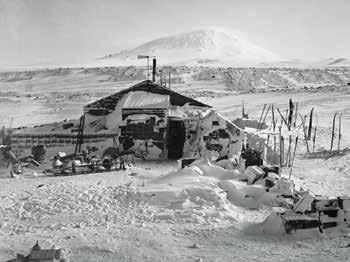
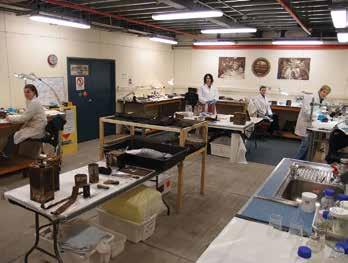

of tinned foodstuffs, set of long-johns, or part of the acetylene lighting system. The diversity is enormous and we find the objects fascinating, so our interest levels remain high and it’s not difficult to maintain the motivation throughout the long winter months.
And who, other than us, actually gets to see all of these things and appreciate this work? Perhaps more people than you might expect, with about 500 tourists visiting on expedition cruises each season as part of a maximum of 2,000 visitors per hut per year (under a permit system) – plus an unlimited number through Google Earth, which now offers an online virtual tour.
To learn more about the Antarctic Heritage Trust’s work and follow the on-ice activities of the team during the winter of 2014 through weekly Antarctic blogs, go to www.nzaht.org. Blogs are also hosted by the Natural History Museum, London, at www.nhm.ac.uk/natureplus/community/ antarctic-conservation
01 Inside Nimrod hut, which had been prefabricated in London, and was erected at Cape Royds, Ross Island, by Ernest Shackleton’s British Antarctic Expedition of 1907–09. From here, Shackleton’s party reached the furthest point south at the time, 156 kilometres short of the South Pole. The conservation of the 6,000-plus artefacts in the hut was completed by the Antarctic Heritage Trust in 2008. An ongoing monitoring and maintenance program is now in place.
02 Scott’s Terra Nova hut at Cape Evans today.
03 Hut and Mount Erebus photographed by moonlight, taken by Herbert G Ponting on 13 June 1911, during Robert Falcon Scott’s British Antarctic ( Terra Nova) Expedition of 1910–13. Canterbury Museum. Reproduced with permission
04 The conservators at work in their winter lab in the Hillary Field Centre, Scott Base, Antarctica.
05 Some of the members of Ernest Shackleton’s British Antarctic Expedition of 1907–09 at Nimrod hut. Canterbury Museum. Reproduced with permission
We know where each man slept, their clothing sizes and what they wore (under as well as over!), what many of them did daily, and often, from their writings, what they felt
 The immaculate SY Ena was a visiting vessel at the museum in early 2014.
Photograph Zoe McMahon/ANMM
The immaculate SY Ena was a visiting vessel at the museum in early 2014.
Photograph Zoe McMahon/ANMM
ANMM.GOV.AU/ARHV This online, national heritage project devised and coordinated by the Australian National Maritime Museum reaches across Australia to collate data about the nation’s existing historic vessels, their designers and builders, and their stories.
The latest additions to the Australian Register of Historic Vessels reflect the great variety of craft to be found around Australia, writes its curator David Payne. Among them are vessels from the last days of the nation’s whaling industry, two sailboats by famous Sydney boatbuilders Bill Barnett and Magnus and Trygve Halvorsen, an Edwardian gentleman’s steam yacht and a former Cold-War submarine.
THE AUSTRALIAN REGISTER of Historic Vessels (ARHV) maintains its diversity with its latest selection of craft, some of which link to recent or current events and exhibitions at the museum.
SY Ena, built in 1900 as a luxury steam yacht for Sydney banker Thomas (later Sir Thomas) Dibbs, is one of a precious few Edwardian steam yachts anywhere in the world. It has been in Sydney for 25 years, but almost untouchable and largely out of view under protective covers. From February to May, however, this impressive 35-metre vessel was on display at the museum, its covers off and a stunning sight.
The steam-powered whale catcher Cheynes IV and one-time whale towboat Georgic are among the few vessels remaining with connections to the local whaling industry; both come from
Albany (see stories on pages 2 and 54). Their worked ceased in the late 1970s when the government banned whaling in Australia, recognising that these mammals should be protected, not exploited. The museum’s exhibitions Amazing Whales (until 14 July) and Beautiful Whale (until 1 February 2015, and previewed in Signals 106) celebrate these spectacular creatures.
Boambillee is an exceptionally strong and elegant ocean-racing yacht, built by Bill Barnett, who also built Myra Too (see story on page 40). Boambillee ’s cold-moulded construction helped to make it very robust; the recently launched replica of Myra Too has a similar construction.
Our new Warships Pavilion (see story on page 36) will be one of the museum’s most significant features when it opens, and will link up with our floating exhibits HMA Ships Vampire, Advance and Onslow Western Australia has one of Onslow ’s sister submarines, HMAS Ovens, and the vessels share a similar story of Cold-War stealth operations in the waters around Australia.
The museum is constantly looking for opportunities to work with other institutions, and for this reason the ARHV seeks out craft from a wide variety of museums. The Australian Museum has a number of Indigenous watercraft, and three more bark canoes from its collection have been included in the register. The craft in the Newcastle Maritime Museum’s collection have a strong regional focus, and three from the area’s well-known builder N & E Towns have been added to the list. Much further south, Mallacoota & District Historical Society has always had an exhibition and material relating to the wreck of SS Riverina in 1927, a significant local event.
Recently they acquired one of the ship’s lifeboats that successfully transferred the passengers ashore from the beached vessel, and they intend to restore it to its lifeboat configuration.
SY Ena, built in 1900, is one of a precious few Edwardian steam yachts anywhere in the world
Yachts and yachting have been strongly represented on the ARHV, and three more yachts were added this quarter. Both Lucienne and Frances share Port Phillip as their sailing grounds and have been on the bay for decades. Lucienne has been racing at club level and cruising on the port, especially around Geelong, but Frances was one of the famous yachts of the Sayonara Cup, the premier trophy for Australian yachting from 1903 to 1962. Frances holds the title of the first Australiandesigned and built yacht to both win and defend the cup, racing on behalf of Victoria.
Freya is one of Australia’s most famous ocean-racing yachts and a tribute to its builders, brothers Trygve and Magnus Halvorsen. It was featured in Signals 105 to note the 50th anniversary of its stillunequalled consecutive triple win in the Sydney–Hobart race. Another anniversary falls this year – it will be the 70th time the famous race has been held, and the museum is considering arrangements to help celebrate this milestone with the race’s home club, the Cruising Yacht Club of Australia.













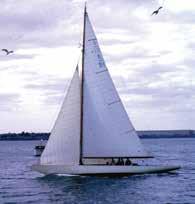




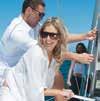


THE BOMBING OF DARWIN IN 1942 by Japanese aircraft is notorious as the day war came to Australian shores. One of the lesser-known stories from the attack is that of the Filipino wharf workers and merchant mariners who died as a result.
On the morning of 19 February 1942, 242 Japanese aircraft made two raids on Darwin, attacking the town’s harbour and its two airfields in an attempt to prevent their use by the Allies as bases to fight the invasions of Timor and Java. These raids constituted the first time the continent of Australia was genuinely threatened by an armed enemy. Through a combination of factors, casualty figures were not well documented. In the 1942 report of the Royal Commission concerning the attack on Darwin, Mr Justice Lowe numbered the deaths at 243; however, many deaths were double-counted or miscounted, and some were never counted at all.
When all of the known errors and omissions are taken into account, the amended casualty roll numbers 252 known deaths. Of these, 21 were Filipinos. Some were Australians of Filipino descent who were local Darwin residents, from families that had been in Australia since the 1880s or even earlier. Employed as wharf labourers, they were killed during the first air raid on Darwin. A second group was among the 105 Filipinos serving as merchant sailors on the supply ships SS Florence D and SS Don Isidro, which had been contracted by the US Army to breach the Japanese blockade of the Philippine Islands. Their secret mission was to deliver supplies to General Douglas MacArthur’s besieged garrison on Bataan Peninsula and Corregidor Island.
Both SS Florence D and SS Don Isidro were engaged by Japanese aircraft off Bathurst Island, north of Darwin, after the first raid. Don Isidro had twice been attacked by a Japanese bomber on 18 February, without damage. Ironically, its captain, Rafael J Cisneros, then turned the ship around to head for the safety of Darwin Harbour – but the next day, seven Japanese Zero fighter planes returning from the strike on Darwin suddenly strafed the ship, destroying the lifeboats and rafts. Don Isidro was later bombed and set on fire, and the crew eventually abandoned ship. The survivors were rescued by HMAS Warrnambool, and Captain Cisneros confirmed that 11 Filipinos had died; their bodies were never recovered. Two more Filipino crewmen, whose names remain unknown, died later in Darwin of their injuries.
On the morning of 19 February 1942, the SS Florence D was busy rescuing the crew of a Catalina flying boat that had been shot down by a Zero on its way to Darwin. Captain Carmelo Lopez Manzano responded to an SOS call from Don Isidro, but Florence D was itself attacked northwest of Bathurst Island by dive-bombers returning to their carrier after attacking Darwin. The ship took five direct hits, including one to the forward cargo hold, which was full of ammunition. After a dramatic explosion Florence D sank immediately, killing three Filipino crew and one American airman from the Catalina.
All of the Filipino merchant mariners killed in these attacks were civilians, serving under Articles of Agreement with the masters of their ships. Although they were on a secret mission to support Allied forces
in the Philippines, on ships engaged by the US military, there were no war medals for them, and their families received little compensation.
Though barely written into any official history, these Filipino casualties made a significant contribution to the maritime history of Australia. The Filipino–Australian waterside workers are listed with the civilians who died in Darwin on a large plaque at the Darwin City Council offices.
On 18 February this year, those killed on the SS Florence D and SS Don Isidro were recognised and honoured on a plaque that was unveiled at Darwin Military Museum, in a ceremony attended by Her Excellency Belen F Anota, Ambassador of the Philippines; Mr Januario John Rivas, Philippine Honorary Consul General of the Northern Territory; and descendants of some of the wharf labourers who were killed. They are also recalled in a Roll of Honour provided by the Northern Territory Library Service (ntlexhibit.nt.gov.au/exhibits/show/ bod/roh/bibliography), which lists all people who were killed that day or died later as a result of the attack.
The wrecks of Don Isidro and Florence D are today protected under the Commonwealth Historic Shipwrecks Act 1976
Edited by Janine Flew from materials supplied by Major (ret) Paul A Rosenzweig. Reproduced with permission. Paul Rosenzweig is a military historian and biographer who has regularly contributed to various Australian historical journals and defence publications over the past 30 years.
In 2011, in time for the 70th anniversary of the Darwin attack in 2012, 19 February in each year was declared a national day of observance, known as Bombing of Darwin Day.
Among the 252 known deaths as a result of the air raids on Darwin, 21 were Filipinos – wharf workers and merchant seamen contracted to US supply ships
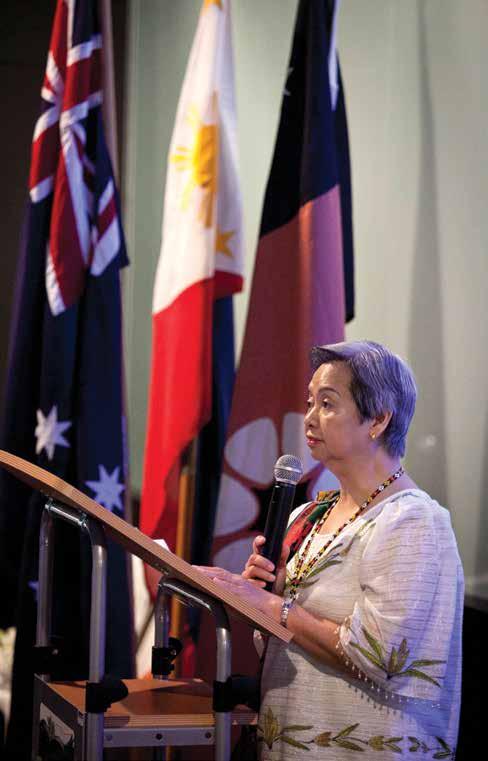
Killed on Darwin wharf
Francisco Augustus Chavez
Ricardo Warivin Conanan
John Roque Cubillo
Domingo Dominic
Catalino Spain
Killed in or as a result of the attack on SS Don Isidro
Antonio Cordova
Raul Delgado
Alberto Jimenea
Melchor Jaruvilla
Loreto Jaime
Amado Logno
Maximo Mangan
Agapito Masangkay
Frederico Montalegra
Antonio Reynes
Quirino Sabando
Unidentified (2)
Killed in the attack on SS Florence D
Francisco Beltran
Librado Briones
Mariano Reyes
01 SS Don Isidro beached and abandoned off Bathurst Island. From the collection of the National Archives of Australia NAA: 302816
02 Her Excellency Belen F Anota, Ambassador of the Philippines, pays tribute to the Filipino merchant mariners who died in the bombing of Darwin. Photograph A Frolows/ANMM



01 A wartime mystery solved In April 1945, during the final months of World War II, eight men from the elite Z Special Unit embarked on a highly dangerous mission behind enemy lines on Muschu Island off the coast of Wewak in Papua New Guinea. Only one man, sapper Mick Dennis, returned alive.
The ill-fated mission, named Operation Copper, saw five Australians killed and their bodies accounted for, but the fate of two soldiers – former St George rugby league club player Lance Corporal Spencer Walklate, 27, and Private Ron Eagleton, 20 – remained a mystery for nearly 70 years.
Recently, new information came to light during an exhaustive research project undertaken by the army’s Unrecovered War Casualties Unit and led by former SAS Major Jack Thurgar. The team examined archival material, including Japanese war records, and interviewed inhabitants of the island, leading them to a grave site on the island of Kairiru, and to the remains of two men. A DNA sample confirmed that, on the balance of probabilities, these were the two missing soldiers, last seen attempting to escape Muschu on a log craft.
On April 20, a memorial service was held for them at the museum, beside the World War II raider MV Krait. In late May, the two men were laid to rest at Lae in Papua New Guinea, in the same cemetery where the other five men from Operation Copper are buried.
Story by Penny Edwell
02 Welcome Wall unveiling In one of history’s great migrations, more than six million people have crossed the seas to settle in Australia.
The museum’s tribute to all of them, the Welcome Wall, encourages people to recall and record their stories of coming to live in this country.
On Sunday 4 May, several hundred people gathered at the museum to celebrate the latest additions to the Welcome Wall.
The guest speaker was Adam Vivan, CEO of Professional Footballers Australia, pictured left with Bruce Djite (centre) of Adelaide United, who unveiled the new panel of names, and museum director Kevin Sumption (right).
To register a name on the Welcome Wall and honour your family’s arrival in this country, please call 02 9298 3777.
03 A visit from our poster girl In March the museum was delighted to welcome Weslee D’Audney, who as a 17-year-old student posed for the poster that was the centrepiece of our recent exhibition Persuasion: American Propaganda Posters from WWII (see story in Signals 106). Weslee and her daughter Carol D’Audney spent two days at the museum, where they toured the exhibition with USA Gallery Manager Richard Wood, met other staff members and participated in radio and television interviews. Weslee is pictured with museum director Kevin Sumption beside a poster bearing the famous image. In a life full of achievement – she gained three degrees, was an associate professor working in the field of early identification of handicapped children, and raised five children – the poster has provided some memorable moments and interesting experiences, and has become an iconic image of wartime America.

Author Michael Pembroke. Published by Hardie Grant, Melbourne, 2013. Hardcover, 304 pages, illustrations, notes, bibliography, index. ISBN 9781742705088
RRP $49.95 (Members $44.95)
A RTH u R PHILLIP: Sailor, Mercenary, Governor, Spy by Michael Pembroke is a remarkable book. While it recounts in detail the career of Australia’s founding governor, Captain Arthur Phillip – the bicentenary of whose death occurs in August this year –its value also lies in its account of the social history of the day and its snapshot of life in that period of the Royal Navy.
Phillip was born in modest circumstances in 1738. His father, Jacob Phillip, was believed to have been a pressed seaman in the Royal Navy. Although Arthur Phillip had first gone to sea as a captain’s servant at the age of nine, his father’s death in service (from possible typhus) made him eligible to be taken in by the Charity School of the Royal Hospital for Seamen at Greenwich. Here he was educated and clothed. He left the school in 1753 and went to sea in the whaling ship Fortune, before joining the Royal Navy in 1755.
Phillip’s progression through the ranks of the Royal Navy was a complex one. Under the tutelage and favour of Captain Michael Everitt, he achieved the rank of lieutenant before being placed on half pay. The narrative goes on to suggest that Phillip spent time spying on the shipbuilding capabilities of France and later on the port facilities of the Spanish in Brazil. He also served in the Portuguese navy for three years, rising to the rank of captain and commanding the captured Spanish 70-gun ship of the line San Agustin. He ultimately returned to the Royal Navy and resumed his previous rank of lieutenant.
Following a period as captain of the fire ship Basilisk, he was made post captain in 1781 and subsequently commanded the frigate Ariadne and the ship of the line Europe. Six years later, he went in command of the much smaller warship Sirius, then about to lead the first fleet to sail to the other side of the world to establish a penal colony in New South Wales. His posting also appointed him as governor of the new colony.
Arthur Phillip is best remembered for this period of his life, and over four years he founded and developed the first white settlement in what was to become Australia. The colony he left in 1792 was by then well established and owed much of its progress to his tenacity and stewardship. He returned to England in poor health but after a period of recuperation returned to sea, holding a number of short sea commands before being posted ashore. In his later years he rose to the rank of Admiral of the Blue. Phillip died on 31 August 1814 and his body was interred in the medieval church of St Nicholas in Bathampton, near Bath.
In 1787, Phillip went in command of the small warship Sirius, then about to lead the first fleet to sail to the other side of the world to establish a penal colony in New South Wales
Arthur Phillip was twice married and gained much of his modest wealth from these relationships. He is painted in the book as a competent officer with a strong sense of service, a belief in justice and more than a little political acumen. The book would be of value to those with an interest in maritime history, readers seeking a digestible account of late 18th-century England and historians wishing to understand the early settlement of Australia.
Reviewer John Dikkenberg is the captain of the museum’s replica HM Bark Endeavour
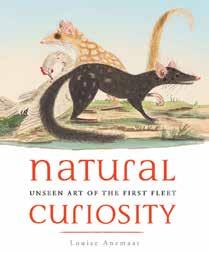
Curiosity – Unseen Art of the First Fleet
By Louise Anemaat, published by NewSouth Publishing, Sydney, 2014. Flexicover, 256 pages, illustrations, notes, index.
ISBN 9781742234090
RRP $40.00 (Members $36.00)
NAT u RAL Cu RIOSIT y paints a picture of early Sydney and the First Fleet’s arrival in both words and images, many of the latter never before published. It gives a stunning account of colonial life from the viewpoint of natural history.
The author, Louise Anemaat, is head of the pictures section at the State Library of New South Wales. Exhibitions that she has curated include the recent Artist Colony, which can be viewed online. A keen student of Australian history, she travelled to London to research this book, which is based on the Lambert collection of art bought by the State Library in 20ll.
Anemaat writes, ‘The public emergence of Aylmer Bourke Lambert’s Australian drawings has been a little like finding that lost piece of the jigsaw’. The discovery of the collection was a rare opportunity for the State Library. It has a staggering 745 watercolour drawings, and is a companion collection to the famous First Fleet Watling Collection, which is kept at the British Natural History Museum. Both have amazing watercolour images of birds, animals and plants from the Sydney region, home of the Eora Indigenous people.
The collector had been a friend of both Sir Joseph Banks, who sailed with Captain Cook, and the naturalist Robert Brown, who sailed with Matthew Flinders on Investigator in l801. He acquired his collection from the First Fleet SurgeonGeneral John White, and it is thought to be the largest single record of the flora and fauna of Sydney. It is also unique
in its inclusion of Aboriginal names of plants, animals and birds where they were known.
Lambert gave some of his botanical studies to Kew Gardens, and upon his death in l842, the collection was bought by the 13th Earl of Derby. It remained in the Derby family library before being purchased by the State Library of New South Wales.
Like Banks, Lambert had an intense personal interest in the natural history of the Antipodes, which then fascinated Britain and many naturalists, zoologists and botanists. Such natural scientists were also greatly assisted by the commitment of the colony’s first governor, Arthur Phillip, to have all the trees and shrubs of the region drawn so that people in the northern hemisphere could study them. Anemaat writes, ‘Phillip in particular was keenly aware of the political dimension of all his natural history activity. He saw it as a way of selling the notion of New South Wales, of securing support and holding the interest of key people in England’.
The depiction of birds and animals showed the great diversity of life here, particularly the prevalence of black cockatoos, richly plumaged ducks, owls, kangaroos, dingoes

and the variety of fish in the harbour, which formed the staple diet of Aboriginal people, convicts and officers until conflicts emerged.
On first viewing the Lambert Collection in London, Louise Anemaat reveals that she nervously took the collection over to the British Natural History Museum to compare it with the Watling Collection. It was a move that paid off handsomely. She found that some of the art was copied from one collection to the other, and she could verify this by the small changes that were made in the art.
Further research revealed that in this era – well before mechanical reproduction, such as photocopying – it was perfectly normal and acceptable for natural history art to be copied, so that if a watercolour image of a particular species was sold or lost, the private owner or museum would still have a replica. As Anemaat says, ‘The idea of copying drawings might seem problematic to us today … [but] copies in the l8th century sense were created simply to circulate knowledge and information’.
Her work unearthed other new discoveries. The first astronomer of the colony, William Dawes, who befriended local Cadigal people, is now credited by Anemaat with early botanical drawings. Dawes’ notebooks are held in London’s School of Oriental and African Studies.
The collection also sheds new light on Thomas Watling, the convict artist responsible for so much of the excellent early British art. Convicts were forbidden to sign their works, but Anemaat believes
that despite his convict background, Watling saw himself as an important artist and therefore signed his art, unlike many of the other practitioners. Today we have a personal record of what Watling saw and painted for our own records.
Louise Anemaat also gives us a very thoughtful account of what motivated men such as Lambert. In those times ‘gentlemen’ often developed passions for history, botany and art and took up collecting. The Linnean Society was open to their interests, and held regular lectures on new scientific and classification finds. Lambert was a regular visitor, like many of his peers.
After the death of Sir Joseph Banks and the emergence of professionalism in science and natural history, Lambert found himself on the outer. But when it seemed that Banks’ plant collection at Kew Gardens would be broken up, Lambert campaigned vigorously to Queen Victoria and Kew Gardens was turned into a natural parkland and research centre, still greatly prized today.
Natural Curiosity is a finely written and designed book, as well as being a rich tapestry of stories and luminous watercolour drawings. It’s a testament to what individuals can do to change the world, and helps us redefine our nation and those who contribute to a greater understanding of the natural world.
Reviewer Margaret Smith is a Sydney writer and filmmaker. Her most recent film, North of Capricorn, is inspired by Professor Henry Reynolds’ book and tells the story of Australia’s history with the Asia–Pacific region.
01 Artist unknown, Hawksbury duck Australasian shoveler (Anas rhyncotis), probably 1790s, watercolour. One of many images in the collection in which the figures of the birds dwarf the surrounding landscape.
Lambert’s Derby Collection, Mitchell Library, State Library of New South Wales, Sydney, PXD 1098, vol 4, f 89
02 Artist unknown, (Solanum aviculare) The fruit of this call’d by the Natives Pommerral and eaten by them when ripe/ Kammarral, watercolour. Lambert’s Derby Collection, Mitchell Library, State Library of New South Wales, Sydney, PXD 1098, vol 5, f 80
03 Artist unknown, Possibly Blue Groper (Achoerodus gouldii), 1788–1800, watercolour. Lambert’s Derby Collection, Mitchell Library, State Library of New South Wales, Sydney, PXD 1098, vol 4 f 26




PERHAPS THE MOST IMPORTANT LESSON
I’ve learnt so far working in Digital Outreach is that you can never predict who is going to use your online collections and in what way. In fact, that’s where the fun is.
In late 2012, while cataloguing the images in the museum’s historic William Hall collection, I came across a set of striking but unidentified sailing photographs in and around Sydney Harbour. The images did not remain a mystery for long. As it turns out, they depicted the action-packed racing of the 1951 18-footer sailing season.
Familiar faces and legendary vessels appear throughout the images, all with the splendid backdrop of 1950s Sydney Harbour. In one photograph, respected sailor and boatbuilder Norm Wright peers up at the camera from his yacht Jenny IV while his crew wrangle ropes around him. Another photo offers a close-up of New Zealander Howard Pascoe’s yacht Result with an early trapeze belt visible at the feet of the crew.
The photographs seemed to focus on one skiff in particular, however. Bearing a distinctive emblem consisting of a large letter ‘M’ within an oval, this was the
famous 18-footer Myra Too. Built by Sydney boatbuilder Bill Barnett, the skiff had blitzed the field in 1951 to take out the state and national titles as well as the coveted J J Giltinan world championship.
If anything proves that the online world is not just for Generation Y, it’s this story
Fortuitously, finding these photographs in our collection coincided with a project to build a replica of Myra Too in honour of the winning exploits of the vessel and the crew, and also the long career of skipper and builder Bill Barnett. This proved to be a rather challenging task, as the half models and designs for the vessel had been destroyed in a fire in the 1970s and the original Myra Too was long lost to time. The Australian Open Skiff Trust, who build and sail replicas of traditional 18-footers on Sydney Harbour, had engaged the museum’s Historic Vessels Curator David Payne to draw up new designs for the
replica using a combination of experience and memories gleaned from Bill Barnett, now 99 years old. With the build almost ready to begin in late 2012, David turned to the newly uncovered photos for more information on Myra Too’s finer details, tweaking his plans before builder Bob McLeod began to bring them to life.
Because of the interest in the project from the sailing community, I uploaded the museum’s historic photographs to the online photosharing site Flickr Commons. Once on the internet, the images proved extremely popular. They were viewed thousands of times, shared, commented on, printed out, framed and used in sailing publications both online and in print. I was contacted by enthusiasts around the country and further afield, from yachting historians in New Zealand and even boatbuilders in the UK, all wanting to provide information about the photographs. They all had the kind of knowledge that really only comes with a lifetime of being passionate about something and they were passing that knowledge to me. The detail that this community was able to provide about these previously unidentified photographs has


greatly enriched our records. One particular contributor, John ‘Steamer’ Stanley, visited the museum on a number of occasions to sit down with me and identify everything from individual sailors such as Norman Wright, to particular events and iconic vessels. For me, the digital outreach was increasingly turning into face-to-face outreach and David and I were thrilled to attend a Myra Too fundraising day in May 2013 that also doubled as an occasion to honour the remarkable career of Bill Barnett.
I was delighted when, in March 2013, the historic photographs reached the computer screen of an original Myra Too crew member, 81-year-old Brian Stewart.
As Brian explained to me on the phone from his home in Queensland, he had ‘just got this Google thing’ and had decided to try typing in the name ‘Myra Too’ to see what would come up. Brian’s online explorations led him to find our images of Myra Too’s triumphant 1951 season, including several photos of himself as the champion crew’s 19-year-old bailer boy.
As David Payne and I continued to document the progress of the build online through
regular blogs and photos, Brian Stewart stayed in touch and prepared to fly to Sydney to attend the launch in March 2014 at the Double Bay 18-Footers Club. His presence at the celebrations added another, more personal element to the celebrations as they provided an emotional opportunity for Myra Too’s two surviving crew members to reunite. Brian Stewart and his wife Betty had plenty of catching up to do with former skipper Bill Barnett and his family, several decades after they had last seen each other.
The contemporary use of our historic photographs in such a lovely community project, and the specialised information provided by that community about our images, have added invaluable layers of meaning and value to our collection. Additionally, through the efforts of this project, the story for our photographs, and indeed for Bill and Brian, does not just end in 1951. As Myra Too takes to the water with the fleet of the Australian Open Skiff Trust during the summer months, this story will now have a new and continually developing chapter – one that we hope will continue to be told online.
As David Payne said to Brian Stewart during a morning tea at this museum the day after the launch: ‘Thank you for using the internet!’ Penny Edwell
Digital Curator
For an online archive about the Myra Too project, see bit.ly/MyraTooOnline.
01 Spectators on a ferry congratulate the crew of Myra Too after it wins the Australian championship in 1951. Skipper Bill Barnett is on the tiller with bailer boy Brian Stewart on the right and sheet hand Fred Evennett in the centre, wearing a white cap.
William Hall Collection ANMM
02 18-footer Myra Too on Sydney Harbour, 1951. William Hall Collection ANMM
03 Betty Stewart, Brian Stewart and Bill Barnett at the launch of the replica Myra Too, 2 March 2014. Photograph Zoe McMahon/ANMM
04 Myra Too replica builder Bob McLeod with his former boss, skipper and builder of the original Myra Too Bill Barnett, with the nearly complete replica, August 2013. Photograph courtesy Bruce Kerridge




Century Of sIlent serVICe
A profile of the unique skills, attitudes, values, challenges and camaraderie of submariners.
$29.95 / $26.95 Members

turner & tHe sea
Explores Turner’s lifelong fascination with the sea, and sets his work within the context of 19th-century marine painting.
$75.00 / $67.50 Members
OxfOrd Illustrated HIstOry Of VIkIngs
The definitive book on these endlessly intriguing Norse raiders.
Special offer!
Normally $49.95 Now $30.00

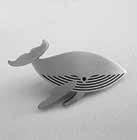
resCue at 2100 HOurs
Profiles the attempt to evacuate a group of 29 Australian airmen from Timor in February 1942.
$29.95 / $26.95 Members

BeautIful WHale
Remarkable close-ups of whales, including full-body portraits compiled from hundreds of images. Accompanies our current exhibition.
$65.00 / $58.50 Members
HuMPBaCk WHale earrIngs
The earrings are made from fine stainless steel and the hook and bead are sterling silver.
$39.95 / $35.95 Members
HuMPBaCk WHale PIn
Sculpted from silverplated pewter, oxidised and buffed to achieve an antique finish.
$25.00 / $22.50 Members
BattlesHIP Bismarck MOdel
An accurate replica, crafted in die-cast metal and plastic, of the German battleship that sank HMS Hood during WWII. Length 36.6 cm
$120.00 / $108.00 Members


Maybe they weren’t.

Mondays 9.30pm AEST
Starts June 9
natgeotv.com.au
/natgeotvau
Epic fails that will leave you in a state of disbelief. Acts of stupidity or simply just a lack of applying the science?
Richard Hammond explains the science behind the fail of some of the most spectacular and painful leaps, crashes, explosions and other misguided mishaps ever caught on film.

Comments or questions about Signals content?
Call the editor 02 9298 3777 email signals@anmm.gov.au
Signals is online
Search all issues from No 1, October 1986, to the present at www.anmm.gov.au/signals
Signals journal is printed in Australia on Sovereign Satin
250 gsm (cover) and 128 gsm (text) using vegetable-based inks on paper produced from environmentally responsible, socially beneficial and economically viable forestry sources
Cert no SGS-COC-006189
01 18-foot skiff Myra Too on Sydney Harbour in 1951, the year in which it won the state, national and world championships. William Hall Collection ANMM
Australian National
Maritime Museum
Open daily except Christmas Day
9.30 am to 5 pm (6 pm in January)
2 Murray Street
Sydney NSW 2000 Australia
Phone 02 9298 3777
ANMM council
Chairman Mr Peter Dexter am
Director Mr Kevin Sumption
Councillors
Mr Paul Binsted
Mr Robert Clifford ao
Mr John Coombs
Rear Admiral T W Barrett am csc ran
Mr Peter Harvie
Mrs Robyn Holt
Dr Julia Horne
Mr Shane Simpson am
Ms Eva Skira
Mr Neville Stevens ao
Signals
ISSN 1033-4688
Editor Janine Flew
Staff photographer Andrew Frolows
Design & production Austen Kaupe
Printed in Australia by Pegasus
Print Group
Editorial and advertising enquiries
Janine Flew 02 9298 3777 signals@anmm.gov.au
Deadline mid-January, April, July, October for issues March, June, September, December
Signals back issues
Back issues $4 10 back issues $30
Extra copies of current issue $4.95
Call Matt Lee at The Store 02 9298 3698
Material from Signals may be reproduced, but only with the editor’s permission. The Australian National Maritime Museum is a statutory authority of the Australian Government.
Foundation partner ANZ
Major partners
Accor’s Darling Harbour Hotels
Lloyds Register Asia
Nine Entertainment
Southern Cross Austereo
Partners
Australian Pacific Touring Pty Ltd
Decorative Events & Exhibitions
Destination NSW
History Channel
Major League Baseball
Metropolitan Touring Ecuador
National Geographic Australia
Professional Footballers Australia
Royal Wolf Holdings Ltd
Sydney by Sail
Founding patrons
Alcatel Australia
ANL Limited
Ansett Airfreight
Bovis Lend Lease
BP Australia
Bruce & Joy Reid Foundation
Doyle’s Seafood Restaurant
Howard Smith Limited
James Hardie Industries
National Australia Bank
PG, TG & MG Kailis
P&O Nedlloyd Ltd
Telstra
Wallenius Wilhelmsen Logistics
Westpac Banking Corporation
Zim Shipping Australasia
ANMM GOV AU